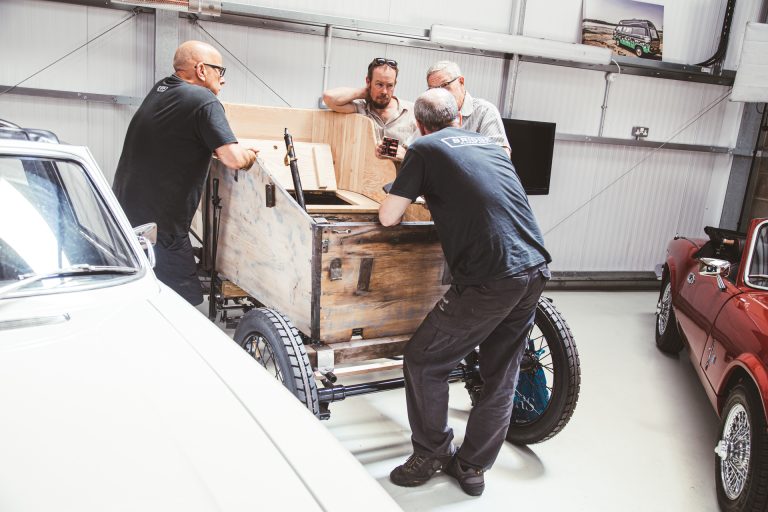
Our Riley Story Continues
Following our recent visit from Geoff Haviland, of the Riley Cars Archive Heritage Trust, he has written us a detailed letter explaining what he believes


Following our recent visit from Geoff Haviland, of the Riley Cars Archive Heritage Trust, he has written us a detailed letter explaining what he believes
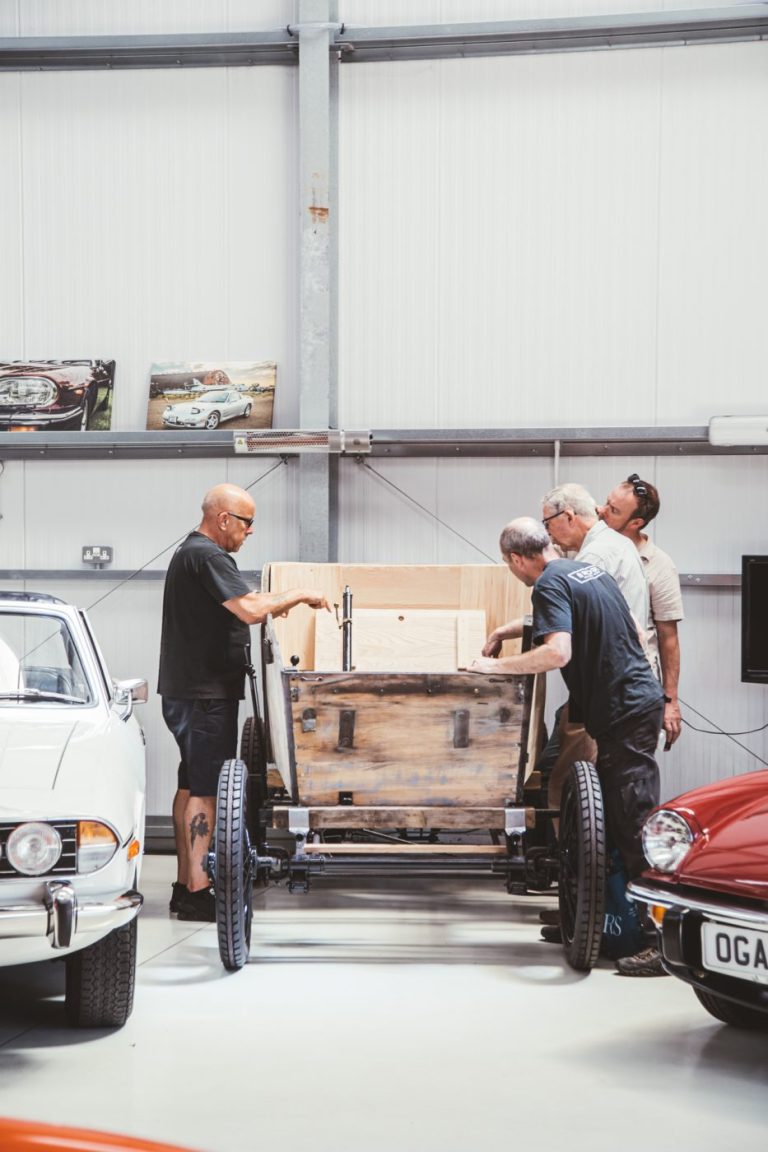
We recently welcomed Geoff Haviland into the Bridge Classic Cars workshop, so he could take a close look at our 1905 Riley 9HP. Geoff was

The wooden body of our 1905 Riley 9HP has returned and has been put in place on the chassis of this potential prototype vehicle. After

Our 1905 Riley 9HP has continued on its way to being restored and rebuilt. Classic car technician Monty has been working on repairing the exhaust

The new wheels and tyres for our 1905 Riley 9HP have arrived at the Bridge Classic Cars workshop. Now that they are here, they can
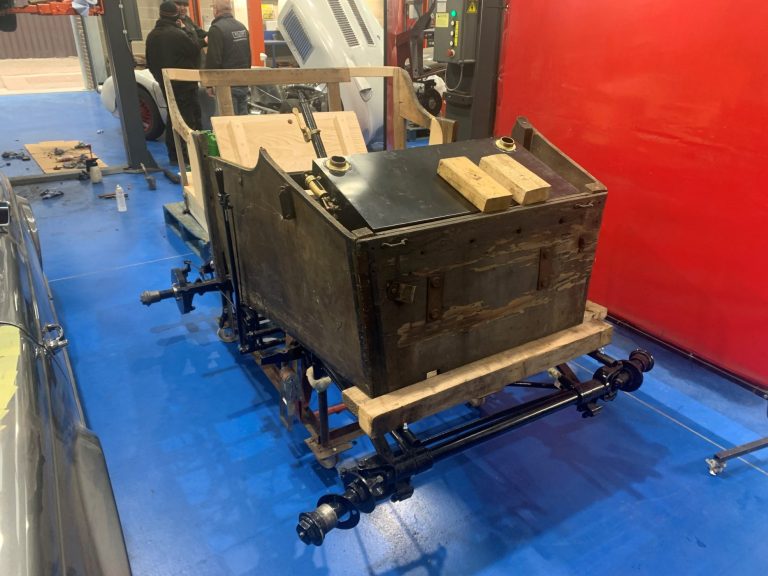
We have always known that our 1905 Riley 9HP is a very special vehicle. It was believed to be just 1 of 3 remaining examples

Since being started for only the second time in several decades, our 1905 Riley 9HP continues to make progress. With so little information about the

Our 1905 Riley 9HP recently came back to life for the second time. Back in December, classic car technicians Dave and John got our Riley
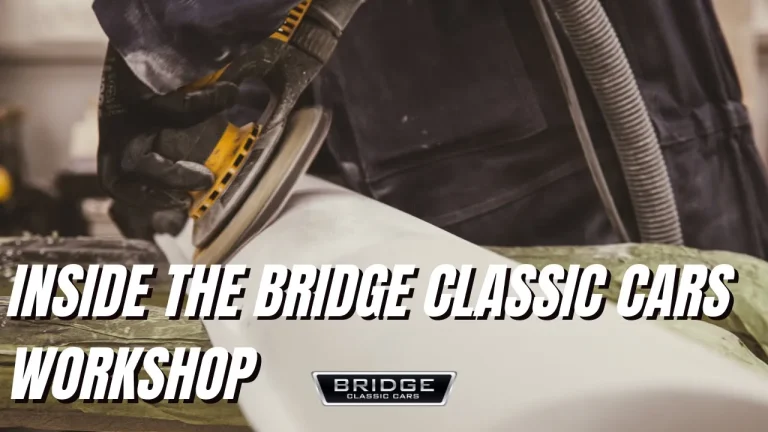
Join Molly as she takes a behind-the-scenes look at what is going on at Bridge Classic Cars.
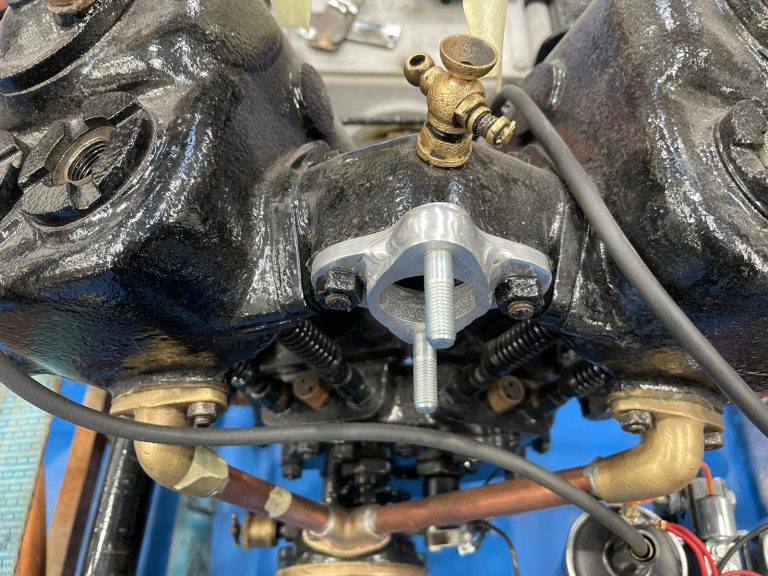
When you are working on a car that is more than 100 years old, like our 1905 Riley 9HP, it is extremely challenging to find
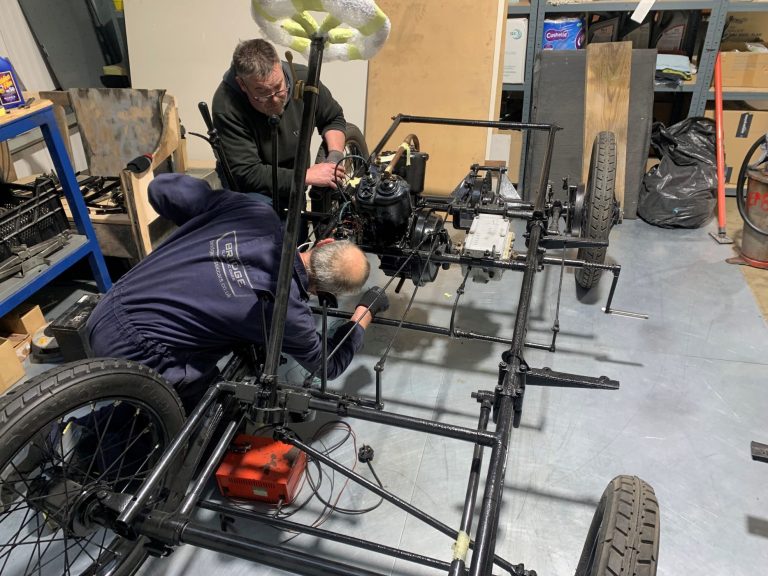
Considering our 1905 Riley 9HP likely hasn’t been started since the 1940s, classic car technician Dave has been working extremely hard to get it back
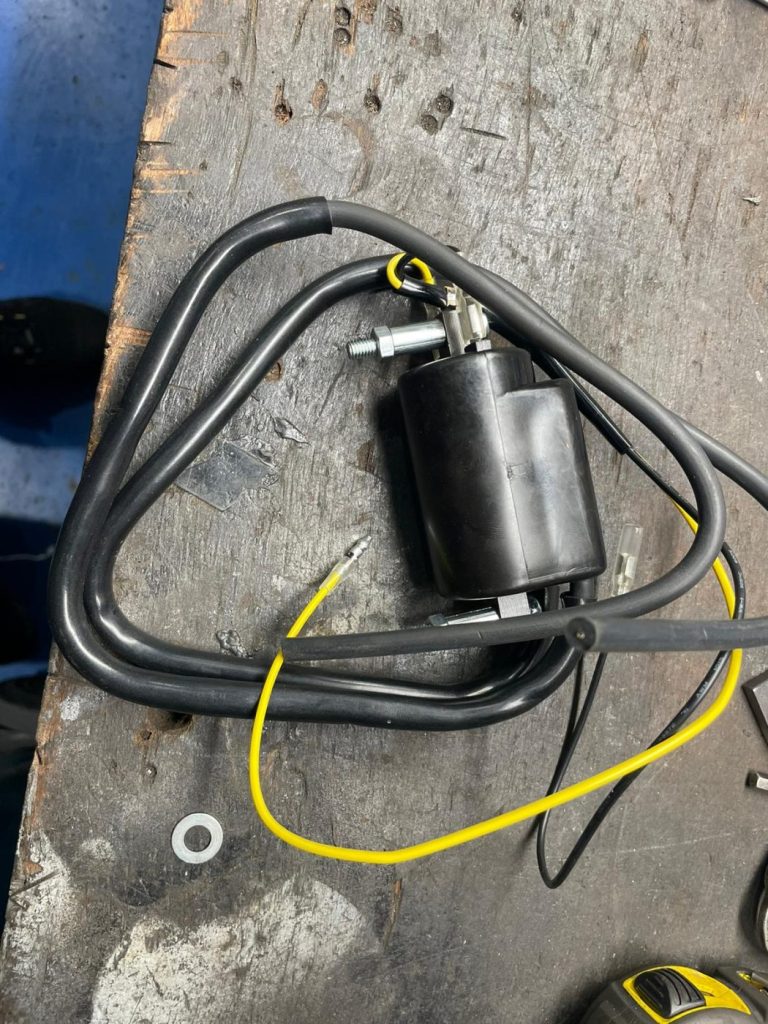
Classic car technician Dave has been continuing his work on our extremely rare 1905 Riley 9HP. After recently trial-fitting the wooden bodywork, Dave has, once
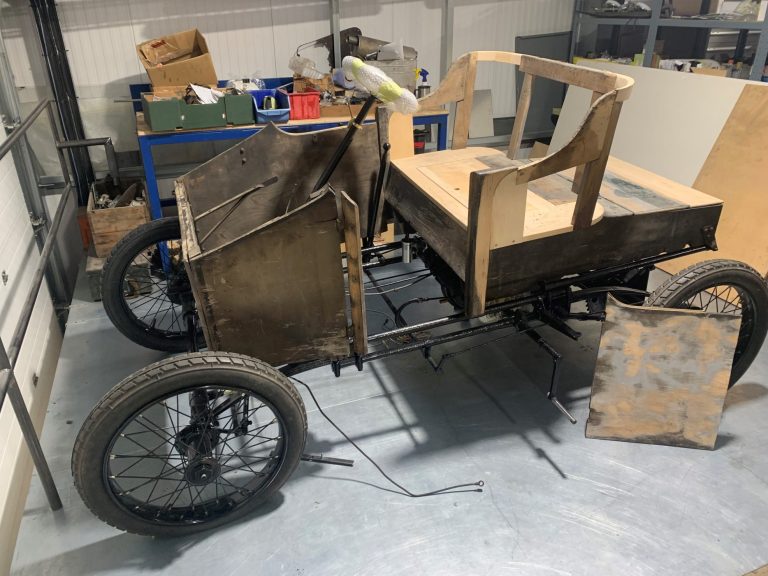
Our 1905 Riley 9HP has been going through a big transformation over the last few weeks. A big step towards this ultra-rare car looking more
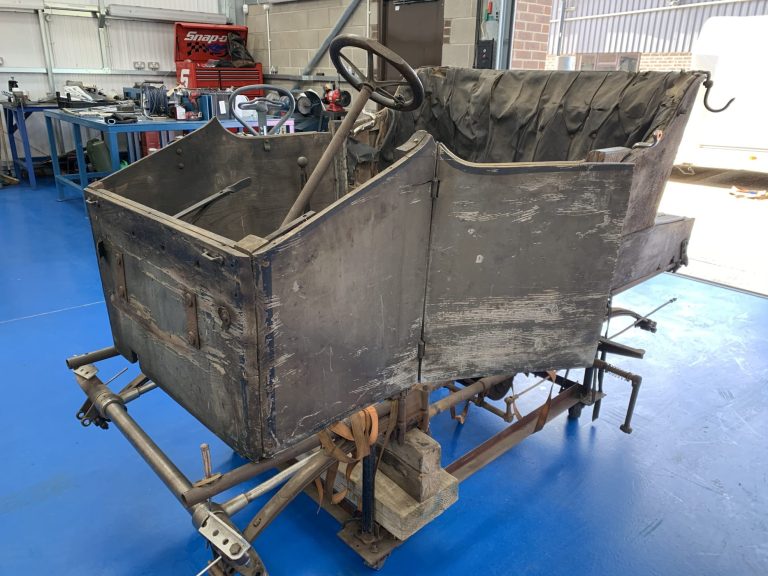
You can’t get much rarer than our 1905 Riley 9HP. With only 3 believed to be left in existence (including the one in our workshop),

Classic car technician Dave has been continuing work on our 1905 Riley 9HP. He has recently added the wheel hub nuts and the nut locking
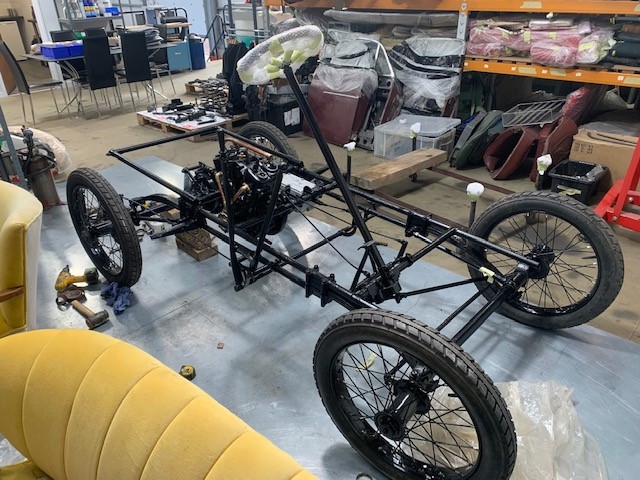
Our 1905 Riley 9HP looks very different to how it looked when it first arrived at the Bridge Classic Cars workshop. Working from photos, drawings,
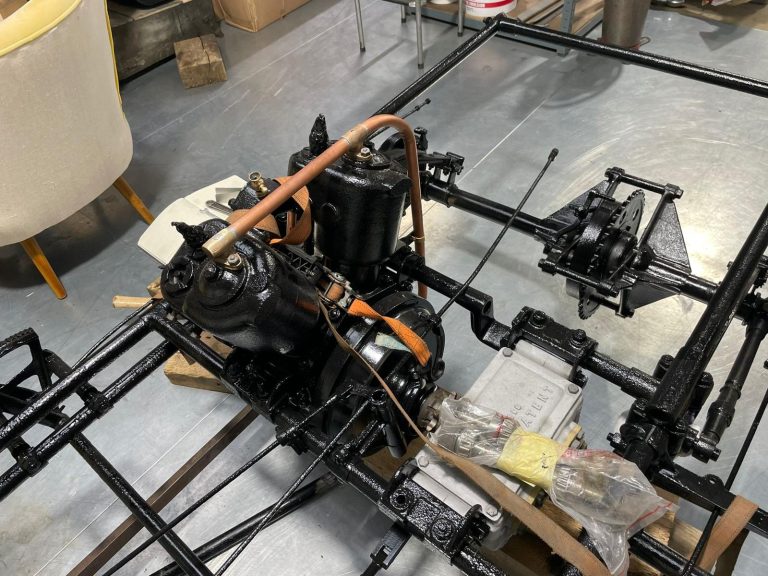
Our 1905 Riley 9HP has been in the Bridge Classic Car workshop for quite some time now. Restoration work on a car like this is

The paint shop at Bridge Classic Cars have prepared and painted the rear axle assembly for our 1905 Riley 9HP restoration project. Since returning from
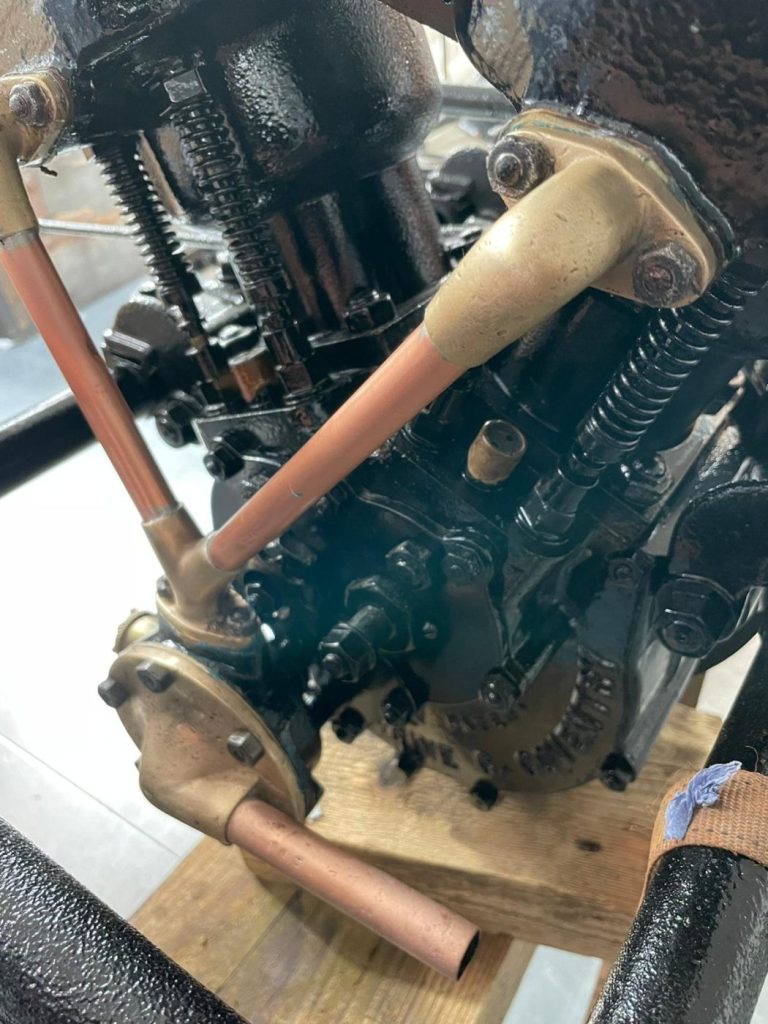
The restoration team at Bridge Classic Cars have been working hard on recreating the coolant system on the 1905 Riley 9HP. Our technician Dave has
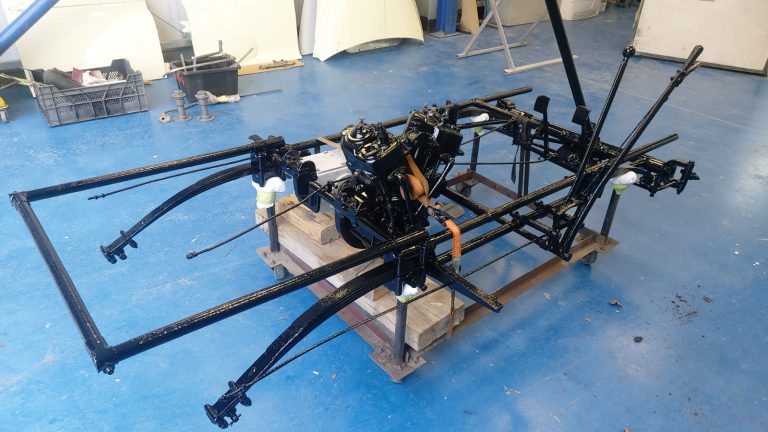
The chassis and engine from the 1905 Riley 9HP has recently been delivered back to the Bridge Classic Cars Suffolk HQ after being blasted by

The rear axle and differential on the 1905 Riley 9HP is on their way back to the Bridge Classic Cars workshop after being sent away
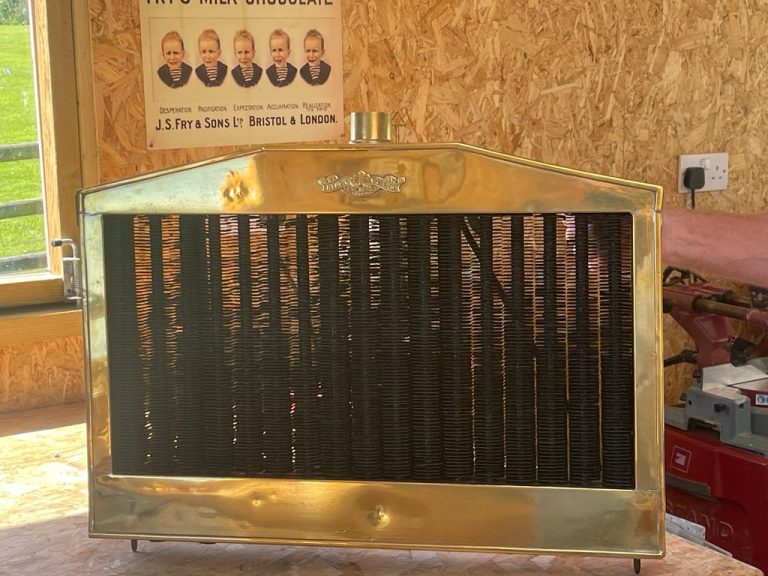
Friend of Bridge Classic Cars, Carl, has been down to pick up the restored radiator for our 1905 Riley 9HP from Newquay for the project.
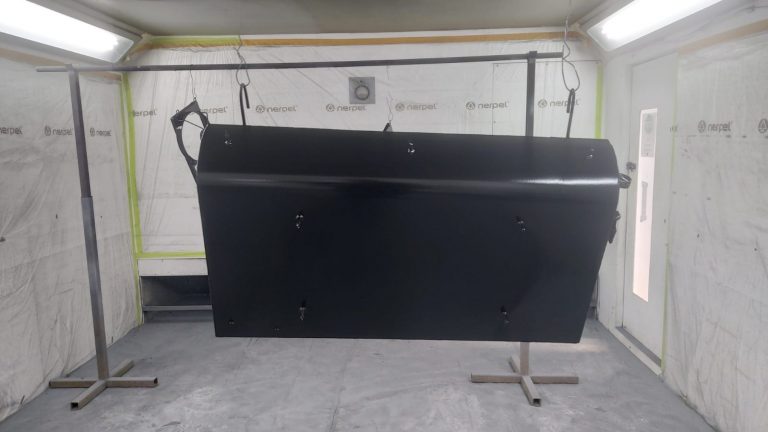
The paint shop at Bridge Classic Cars have painted the restored fuel tank of the 1905 Riley 9HP as part of its restoration. The team
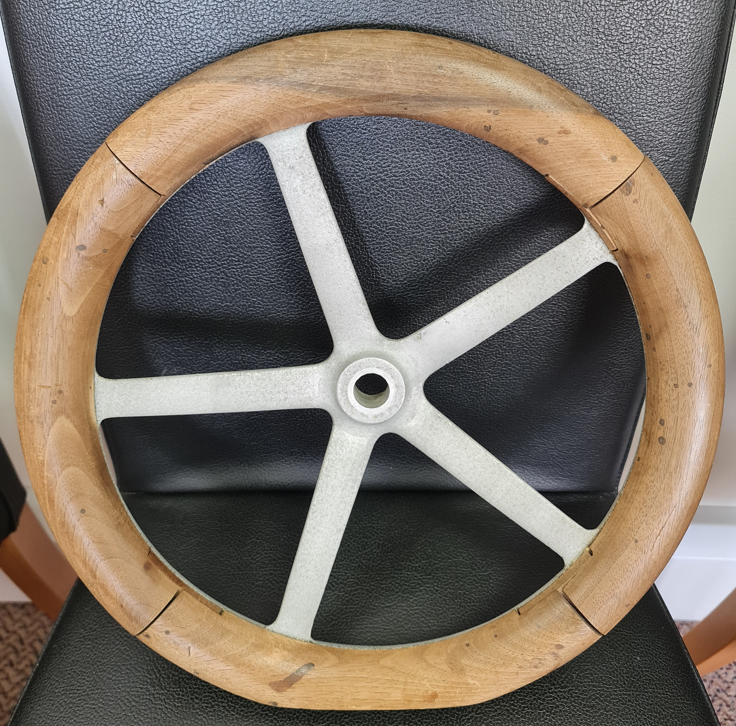
Our 1905 Riley 9HP has had its steering wheel removed by the workshop team here at Bridge Classic Cars to be sent off for a

The workshop team at Bridge Classic Cars have been working on preparing the 1905 Riley 9HP for the next stage of its restoration journey. Our

The 1905 Riley 9HP has had its rear differential and suspension pulled off the chassis to be moved to the workbench for the Bridge Classic

The workshop team at Bridge Classic Cars have begun the process of test fitting and aligning the original rear axle into the chassis of the

The team at Bridge Classic Cars have been working on the restoration of the 1905 Riley 9HP at our Suffolk HQ. The magneto is the
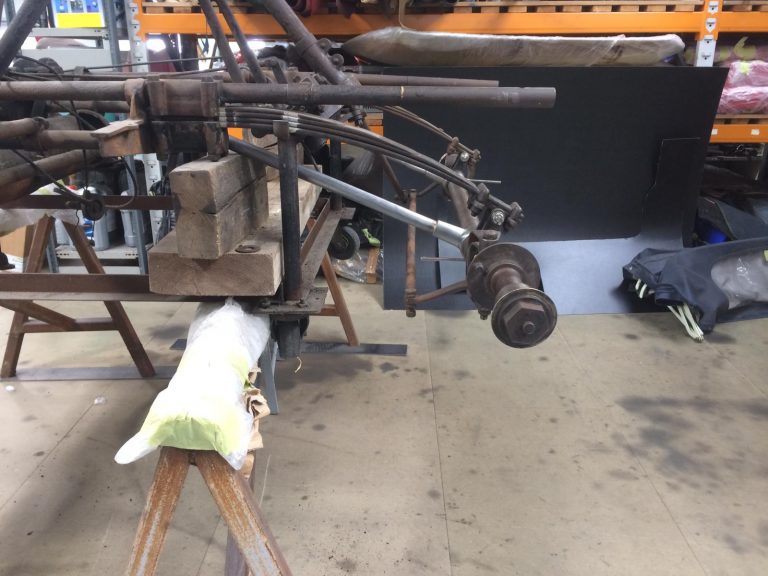
The team at Bridge Classic Cars have performed the first test fit of the new driveshafts in our 1905 Riley 9HP. They have been fit
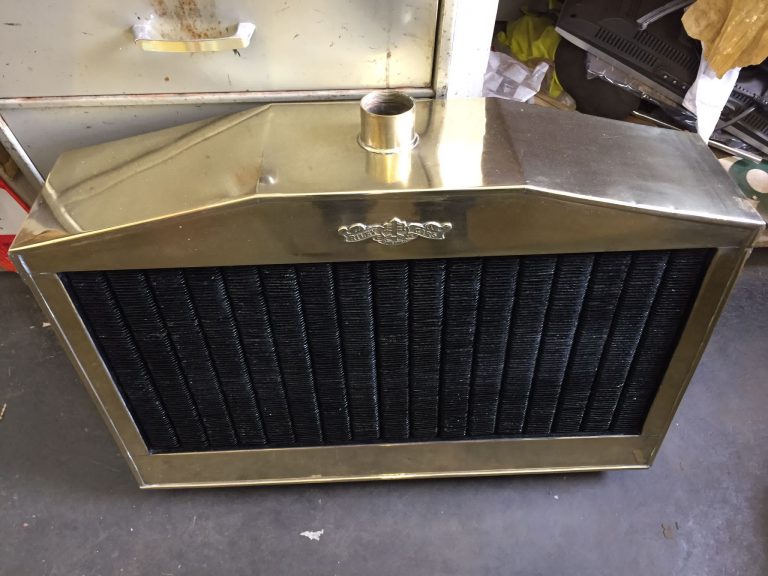
The original radiator for the 1905 Riley 9HP has been with our friends at Newquay Radiators to be completely refurbished and rebuilt for the project.
Following our recent visit from Geoff Haviland, of the Riley Cars Archive Heritage Trust, he has written us a detailed letter explaining what he believes to be another part of our 1905 Riley 9HP’s story. There is a lot of information within his letter and all of it will likely be useful as we continue to restore this extremely rare vehicle.
Geoff’s letter also contained some images and can be read below:
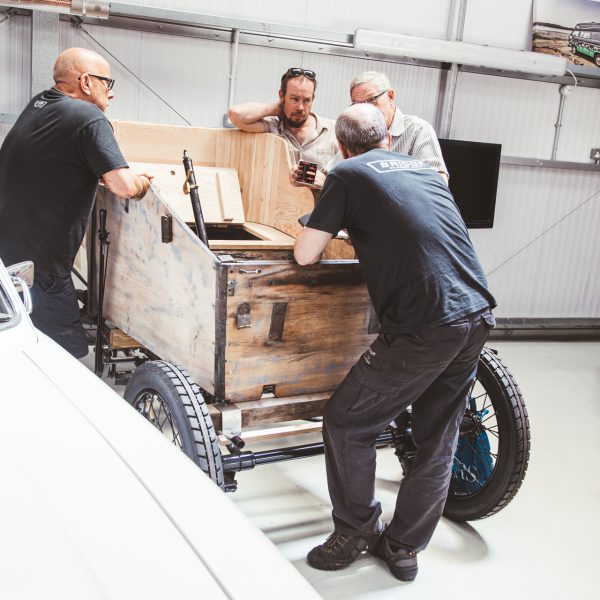
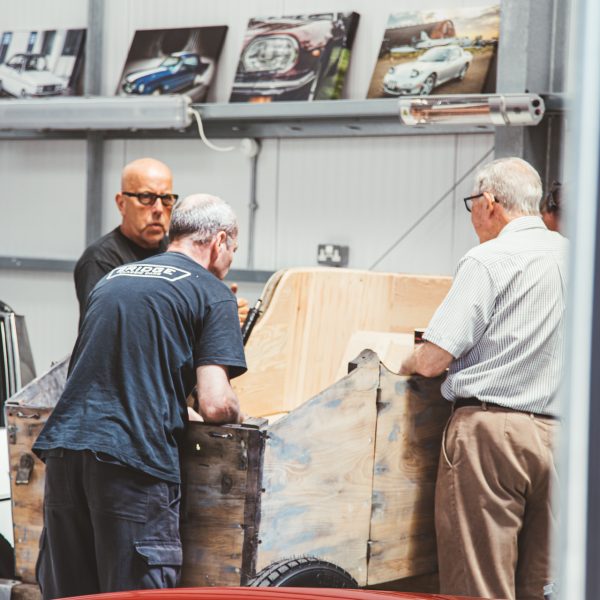
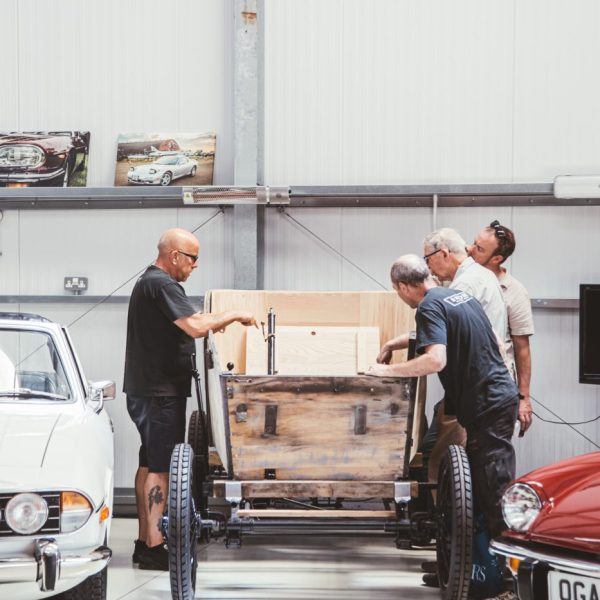
A visit to Bridge Classic Cars in June 2023 enabled me to see this most interesting car. It had been described as a 1905 model and I was very keen to see whether there were differences between it and the two surviving 1907 cars.
At the age of 22 Percy Riley (1880 – 1941) started his own engine company supplying single-cylinder engines to Riley Cycle Co. Ltd for mounting on bicycles and then VTwin versions on Tricars. Engine performance was beginning to outstrip the efficiency of the pneumatic tyres of the period and a burst in the rear wheel of a Tricar at best took two men three hours or more to repair and at worst caused the vehicle to flip over! The answer was to design a car with a wheel on each corner!
Tricars were very popular and continued to be built but were now featuring transverse mounted engines in V-Twin form the first of these appearing in 1905. When the first four-wheeled car appeared it was fitted with the same engine as the 1906 9hp Tricar, two 4 1/2 hp units on a common crankshaft. It is not possible to say exactly when the four-wheeled Riley car was first designed but it was to meet a growing demand for side-by-side motoring and to improve on safety. Riley’s first model was offered to the
public at the Motor Show in October 1906 and was announced as the 1907 Season model but prototypes would have been developed and tested during 1906. Were prototypes built as early as 1905? Looking at the development of the Tricars and the 9hp V-Twin engine this would seem too early but experimental chassis and mock-up body designs may well have been. Riley’s normal practice was to vigorously test out a new chassis in order to eliminate any faults with suspension, steerage, transmission and braking etc. At this stage, the body style was not important and a final approved design would still have been in the future. Successful testing of the chassis would then have led to prototype bodies being mounted on the chassis for further testing, including visual approval. These prototypes would have been much closer to the final design and once any tweaking had been completed the whole design would have been
put forward for approval and production.
Around this time the Stepney wheel appeared. Invented and patented in 1904 this was a ‘get you home’ spare wheel rim without spokes but fitted with an oversize tyre. The rim was clamped to the car wheel and provided a temporary means of getting to somewhere that a flat tyre could be repaired. It fulfilled a need and became so popular that a factory to make them was set up in 1906. Percy Riley regarded them as ‘not an engineering job’ and set out to design a better detachable wheel system. This would have been in 1906 and early efforts would have been trialled on the prototype 9hp cars. By the launch of the car in October 1906 they were only offered as optional extras but became standard fittings in 1907.
No record exists of when Percy’s detachable wheel first saw the light of day but 1905 would again seem rather too early. He may have been working on the system before the Stepney wheel was in full production but family records suggest that he was prompted to design the system on the Stepney becoming so popular.

Currently, there are four known surviving cars and two further ‘kits of parts’. Of the four cars, three are genuine period examples while the fourth is a replica built over the last 30 years by a New Zealander who is now deceased. Unfortunately, this car has been authenticated by the Veteran Car Club of NZ as a 1905 model!
Some doubt exists with chassis numbers as these were stamped onto tubes or cast iron lugs which have deteriorated or been replaced. They cannot be determined in some cases. The NZ car chassis number is clearly fictitious. Engine numbers are more reliable but would have been shared with the Tricars and proper chronological order cannot be determined. Details of the two kits of parts are not yet to hand.
Example 1 Gaydon Motor Museum Reg. YU 4032 Engine No 1112 chassis No. C/105
Example 2 is with Bridge Classic Cars Reg. CW151 Engine No 860 chassis No. 1572
Example 3 is the RCAHT car Reg. 508 WAR Engine No. 1058 chassis No. unknown.
Example 4 is the NZ car Reg BC8512 Engine No 846 Chassis No 740.

The first thought was that this car is a bit of an ugly duckling yet it has the suggestion of the elegant ‘swan’ that was to be presented to the public as the first four-wheeled Riley. It has the look of a mock-up which has been hastily assembled in order to do a specific job, allow the testing of the new chassis, but there are pointers to features that the designer had in the back of his mind.
The chassis details are all similar to the 1907 car except that extension pieces of tube about 10″ long have been fitted at the front. The only reason for having these extensions would appear to be to support the extra length of a flimsy scuttle carcase. The nearside door measures about half of this extra length with the result that it is too narrow and the carcase panel on which it is hinged is too long! There is a lot of wasted space in front of the foot pedals! The radiator has to sit in front of this carcase and so it is too far forward over the front axle. The whole look is of a very stretched front end. The top of this carcase is shaped to follow the slope of the dash panel which may have been thought desirable at the time but it creates a very closed-in look and is not as attractive as the 1907 design. Also, the top of the door is higher than the arm of the seat which has resulted in rather awkward infill pieces being fixed to the seat. The problem has been resolved in the 1907 car by lowering the height of the door and reverting to a plain horizontal line.
The seat is a one-piece double-width single unit and photographs do exist that show early production cars having this type of seat but by the time the 1907 catalogue was issued a double seat was used.
The rear body carcase does seem to have progressed to the eventual design but on this car, the timbers used are considerably thinner.
All of this suggests that this car is very likely an experimental design produced for the test programme of the first four-wheeled chassis. It certainly has the looks of a mockup body using lightweight components and lacking the attractive lines that were to follow. It quite possibly precedes the prototype or prototypes which would have been more similar to the final design. For this reason, I believe that this car came very early on in the evolution of the 9hp car and very possibly before the end of 1905, however, the feature that doesn’t fit with this position is the use of detachable wheels.
Percy would have been extremely busy at that time with the supply of engines to The Riley Cycle Co. Ltd. and others. The Tricar was still enjoying huge popularity and Percy was about to introduce the 6hp and the 9hp engines. He was also overseeing his younger brother Stanley, still only 17 years old in 1905 but about to produce his own 5hp Tricar. Add to this Percy’s time spent on the design work of the new four-wheel chassis which leaves little time left for designing a detachable wheel system. We don’t know that the idea had even occurred to him at this stage.
The most likely scenario is that CW151 was fitted with the detachable wheels sometime later in its very long lifetime.
All in all a most intriguing motor car that perhaps presents a bit of a dilemma for Bridge Classic Cars. When deciding on the best way to restore the car there would appear to be three options.
Restore it to its original form as an early mock-up. This entails keeping its stretched appearance and its flimsy body construction but will be historically correct. It would also be preferable if detachable wheels are not used in this case as they came late in 1906 and were not standard until 1907.
Restore all the parts as acquired, retaining the detachable wheels which would then need to be described as a later modification.
Construct the body in its final production form of 1906. The attraction here is that a more attractive, sturdy and usable car would result.
My own preference would be option 1 as this car is unique as a ‘moment in time’ in the Riley story. However, the finished restoration would be more suited to museum or display purposes and would need special handling if it is to last another hundred years. Option 2 would also be acceptable but the later wheels would slightly detract from the ‘moment in time’ argument. Whilst I wouldn’t like to see option 3 go ahead I would understand it from a commercial point of view. BCC are spending a great deal of money in restoring the parts to the highest standard and they would naturally expect a good return on this investment. There is little doubt that a good restoration to the specification of the production model would be the more attractive in design and the most reliable in performance and durability and would thus attract greater interest. This would be a pity in my view as there are two other surviving 1907 cars but nothing else quite like this one!
Geoff Haviland
Riley Cars Archive Heritage Trust.
28 June 2023
We recently welcomed Geoff Haviland into the Bridge Classic Cars workshop, so he could take a close look at our 1905 Riley 9HP.
Geoff was the individual who reached out to us after seeing our Riley project online. He noticed that our car looked different to how it should, and seemed to be a year or two older than it should have been. It was from his information that it now appears that our 1905 Riley 9HP could very well be a prototype of the very first car to have removable wheels.
The level of knowledge that Geoff has about Riley cars is extraordinarily high. In fact, he was one of the main people involved in a project to build a replica of the first Riley car ever made. What makes this even more impressive is that there was almost no information at all about the original car when the project began but, with a lot of hard work, the replica project got underway.
It was great to have Geoff come and see us and our Riley 9HP. Classic car technician Steve, who has been working on the vehicle, spoke at length to Geoff to help confirm some details he will need to finish our project in the near future.
Everyone here at Bridge Classic Cars would like to thank Geoff for taking the time to visit us and for sharing so much of your knowledge and experience.


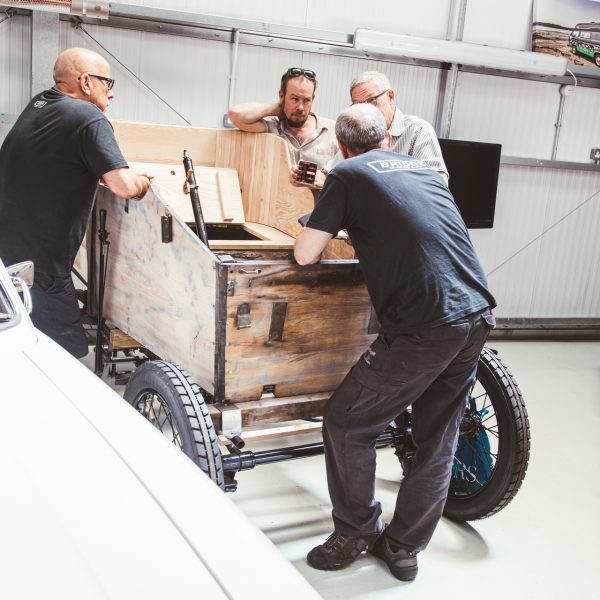

The wooden body of our 1905 Riley 9HP has returned and has been put in place on the chassis of this potential prototype vehicle.
After finding out that our Riley is likely even rarer than we initially thought, it’s great to be able to preserve so much of the original bodywork as we work to restore and bring this historic vehicle back to life.
As the bodywork was carefully lifted into place, you can clearly see the shape of the car really starting to come together.
Now that the body is back with us, the restoration can continue as our Riley 9 gets one step closer to driving out of the Bridge Classic Cars workshop.

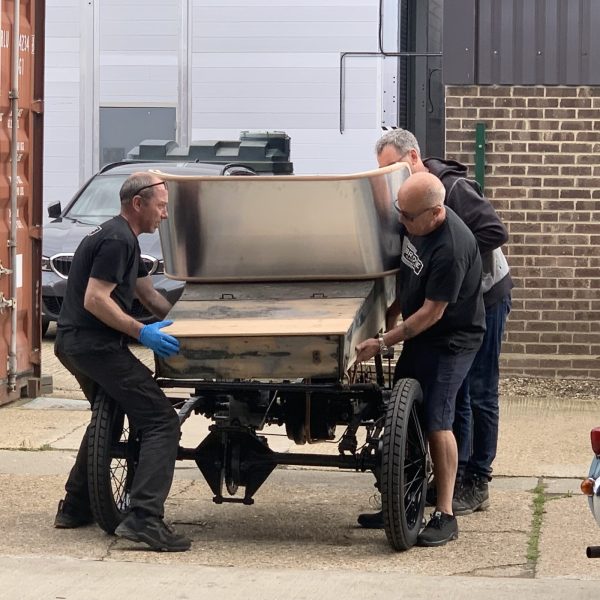


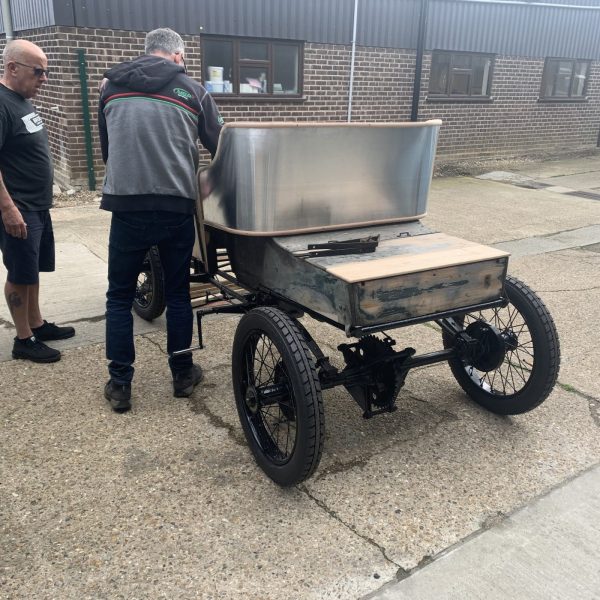

Our 1905 Riley 9HP has continued on its way to being restored and rebuilt.
Classic car technician Monty has been working on repairing the exhaust of this prototype car. He was unable to completely finish his work as he is waiting for some extra parts to arrive before he can fully repair and refit the exhaust.
Work continues on restoring this potential 1-of-1 vehicle and we are looking forward to seeing its progress continue.

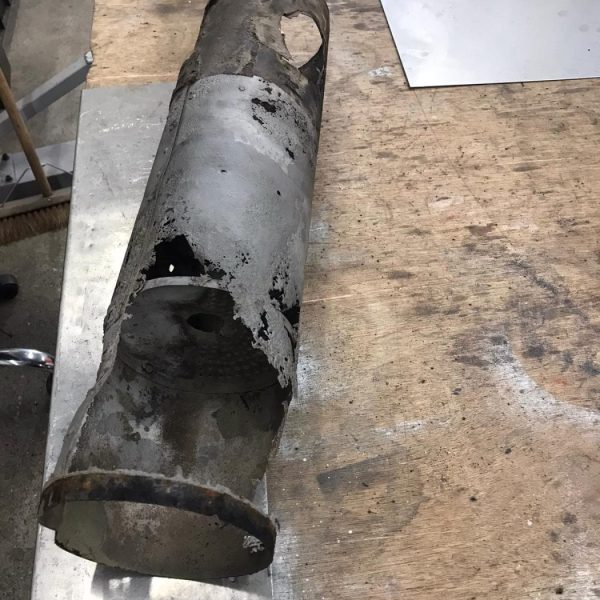

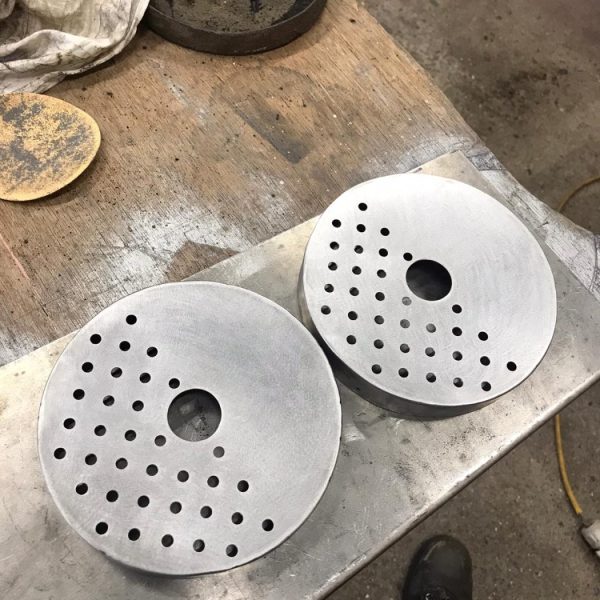
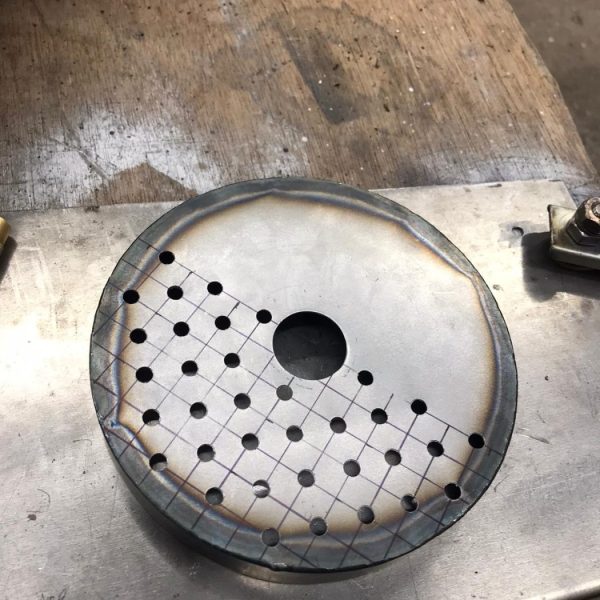
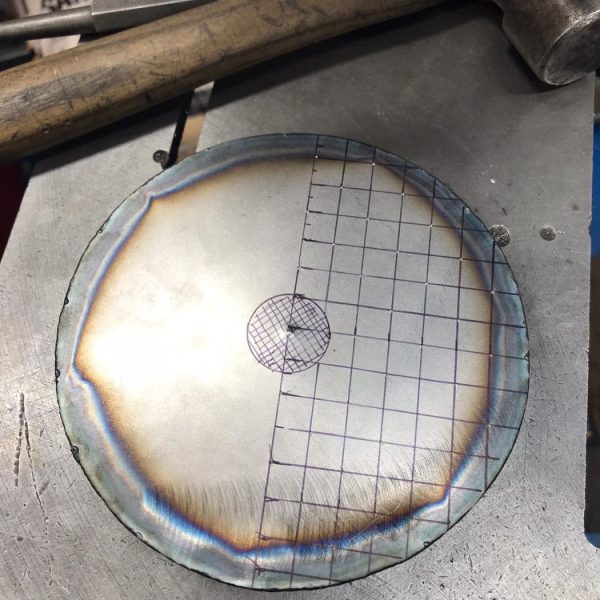


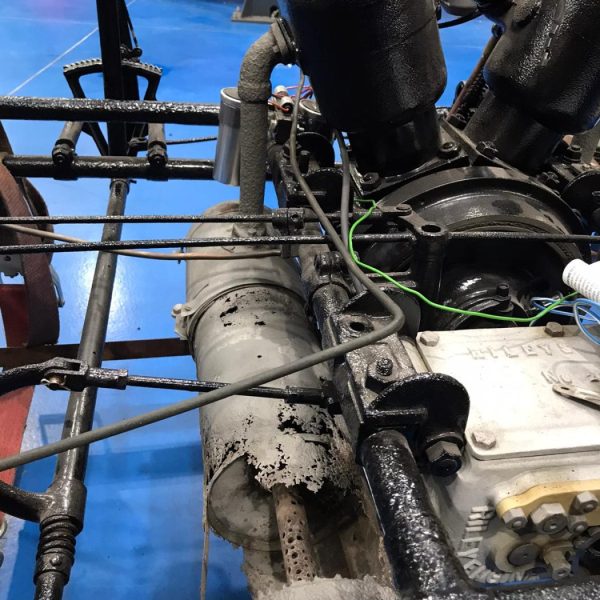
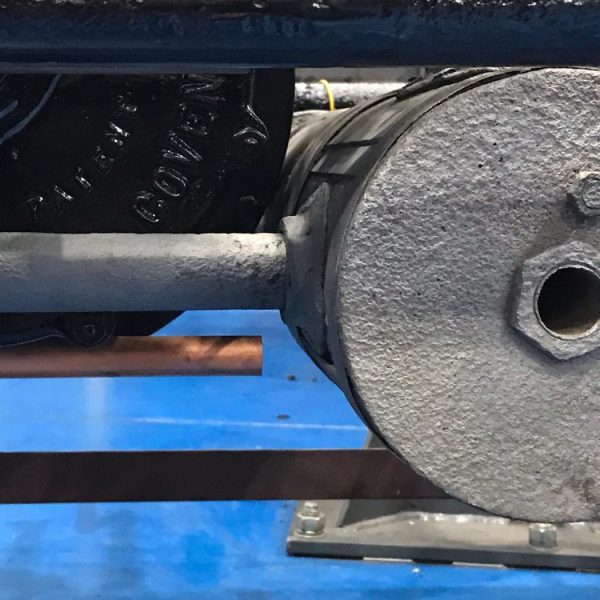

The new wheels and tyres for our 1905 Riley 9HP have arrived at the Bridge Classic Cars workshop. Now that they are here, they can be prepared and fitted to our very special Riley.
Since it now seems that our Riley is a prototype for the first car to have removable wheels, the arrival of new wheels and tyres becomes even more interesting.





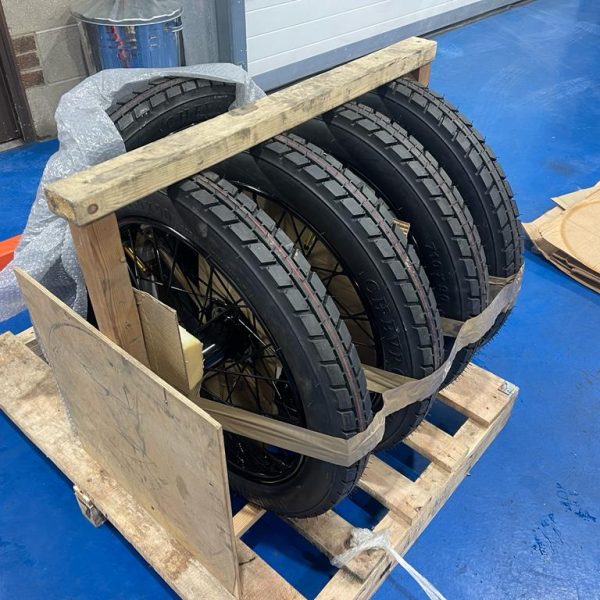
We have always known that our 1905 Riley 9HP is a very special vehicle. It was believed to be just 1 of 3 remaining examples since it first arrived in the Bridge Classic Cars workshop, however, we have recently learned that it might actually be even rarer and even more special than that!
After being contacted by Geoff Haviland, Chairman of The Riley Cars Heritage Trust, it appears that our Riley 9 is likely to be a prototype for the model that went into production, and was the first automobile to come with removable wheels. If this is the case, then it is a possibility that our Riley is the very first of the first cars to have removable wheels.
The Riley 9HP V-Twin was first released to the public at the 1906 Motor Show and was known as a 1907-season car. However, we have information to say that our Riley dates back to 1905, again, indicating its prototype status. The bench seat of our 9HP also shows its prototype potential as the vehicles that came off the production line had 2 seats instead of the one that ours has.
All signs seem to be pointing to the fact that our 1905 Riley 9HP is something extraordinarily special and helped to lay the foundations of the highly successful run of Riley vehicles that followed.
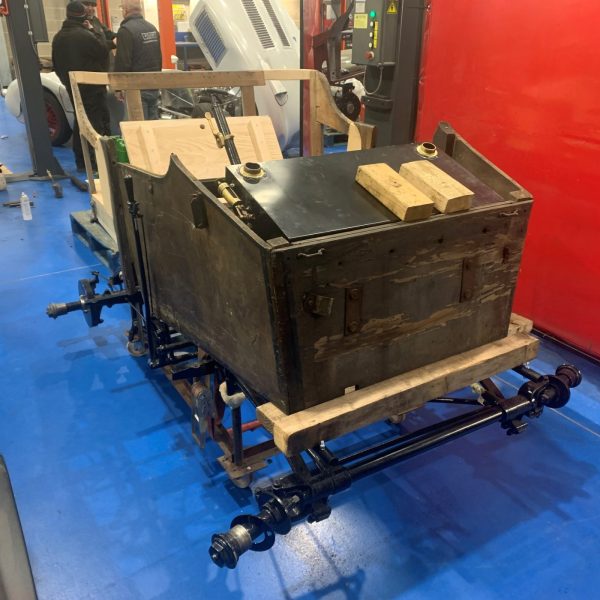

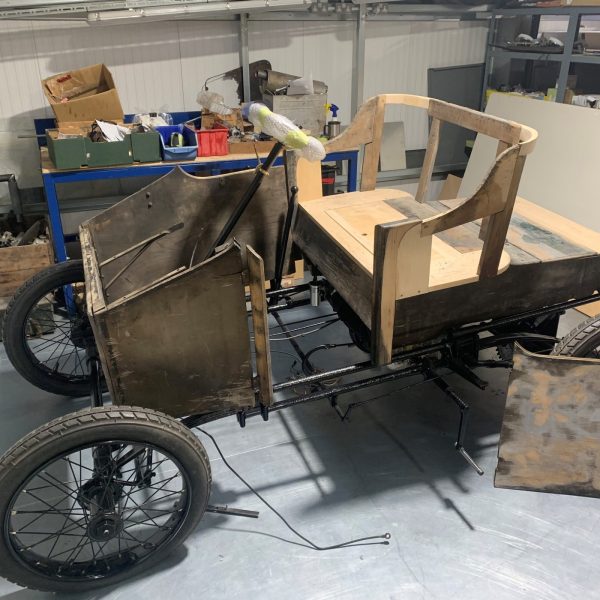
Since being started for only the second time in several decades, our 1905 Riley 9HP continues to make progress.
With so little information about the vehicle available, our team of classic car technicians are working extremely hard to recreate, rebuild, and bring this rare classic back to life.
Recently, some of the wooden bodywork was re-fitted to our Riley to see what further work needs to be completed on it. The fuel tank was also attached and the holes where the radiator will eventually be attached can be seen in front of this.
Our 1905 Riley 9HP will be restored to as close to original as possible and, with the bodywork starting to come together, it is an exciting time in the Bridge Classic Cars workshop.

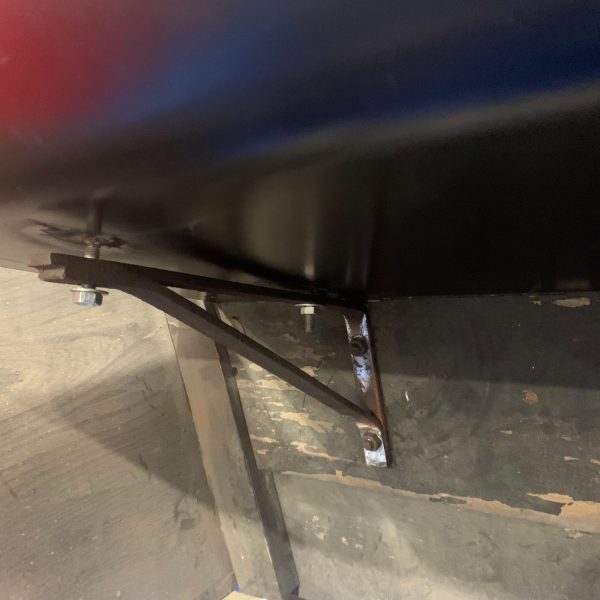
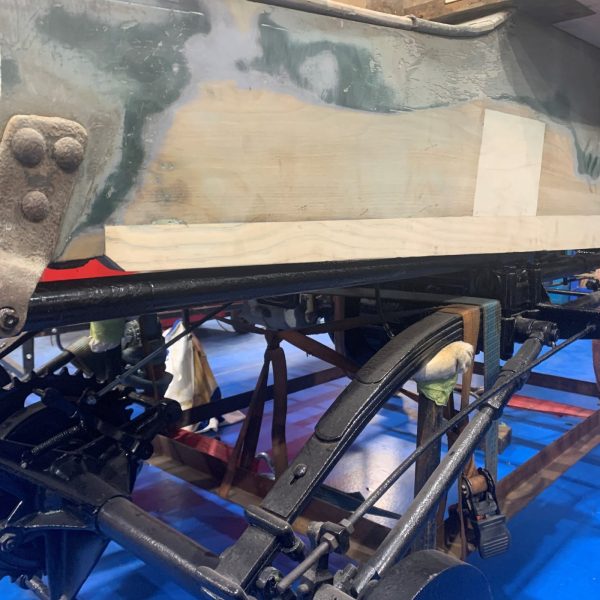
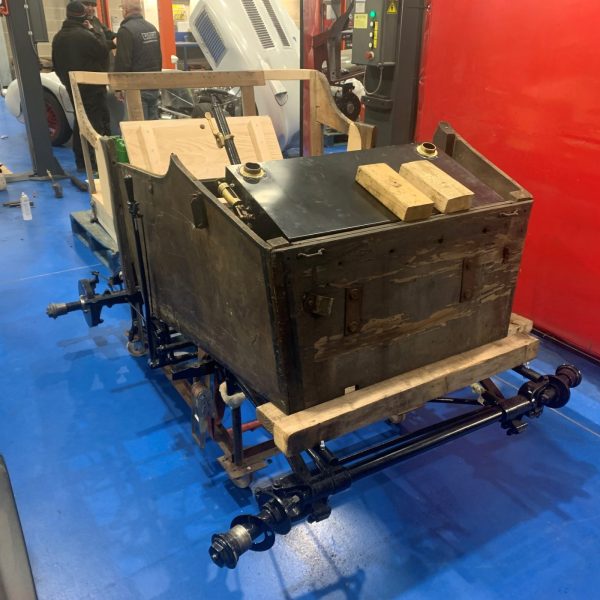
Our 1905 Riley 9HP recently came back to life for the second time.
Back in December, classic car technicians Dave and John got our Riley started for the very first time in decades. Recently, they fired it up one more time and, like before, it was a special moment to see a car that is more than 100 years old burst into life.
As the workshop team continue to restore this extremely rare vehicle back to its original condition, these milestones are important to remember.
With only 3 of these cars believed to be left in existence, we are very proud to have captured the moment our 1905 Riley 9HP started for only the second time in many years.
Join Molly as she takes a behind-the-scenes look at what is going on at Bridge Classic Cars.
When you are working on a car that is more than 100 years old, like our 1905 Riley 9HP, it is extremely challenging to find all of the parts you need in a ready-made state.
That’s why classic car technician Dave has been putting his experience and skills to good use by making a carburettor plate for our ultra-rare Riley.
Our 1905 Riley 9HP is believed to be one of just 3 examples left in existence so getting it back up and running is a task we are taking very seriously.
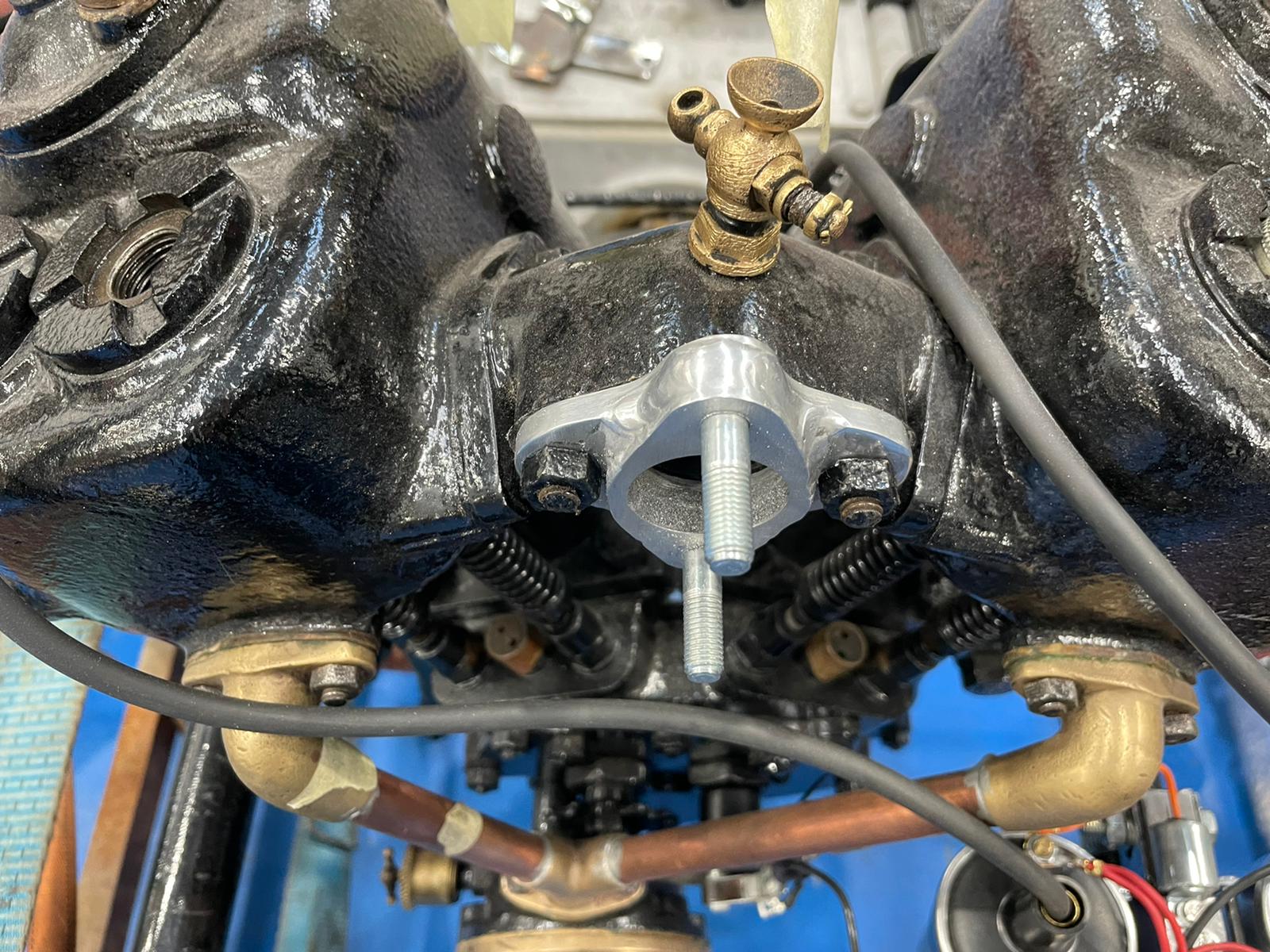
Considering our 1905 Riley 9HP likely hasn’t been started since the 1940s, classic car technician Dave has been working extremely hard to get it back up and running.
At more than 100 years old, you’d be forgiven for thinking that the days of our ultra-rare Riley HP running are long gone, but we are incredibly excited to say that this is not the case!
With some help from workshop manager John, Dave was able to bring our Riley back to life and managed to start it up recently.
Starting a car like this isn’t as easy as turning a key in the ignition, a lot of effort is needed to turn the crank to get things fired up and running as they should.
Long before Dave knelt down next to the car and started his effort to ignite it back into life, he spent countless hours getting it into such a condition where starting it up was even considered a feasible option.
It may have only been running for a few seconds but, at more than 100 years old, after being sat in place since the 1940s, and with only 3 of these stunning cars thought to be left in existence – those few seconds of running were more than enough to get everyone here very excited about what the future holds for our 1905 Riley 9HP.
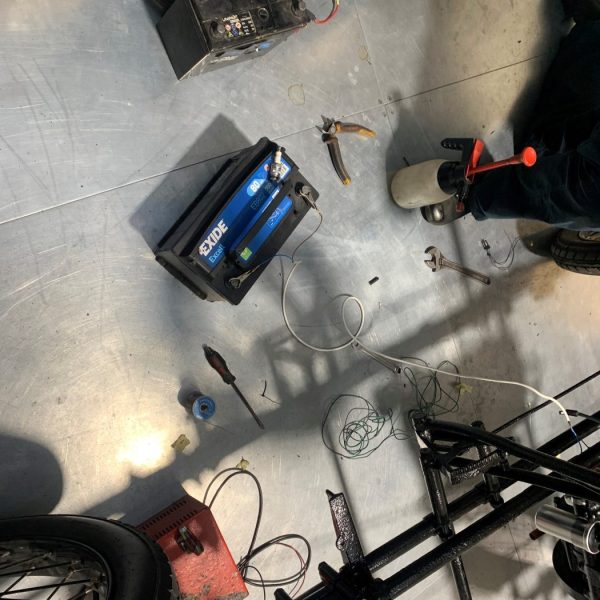
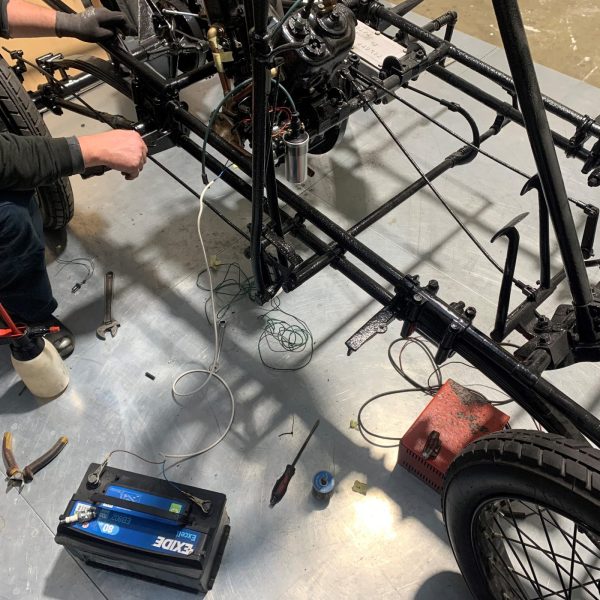

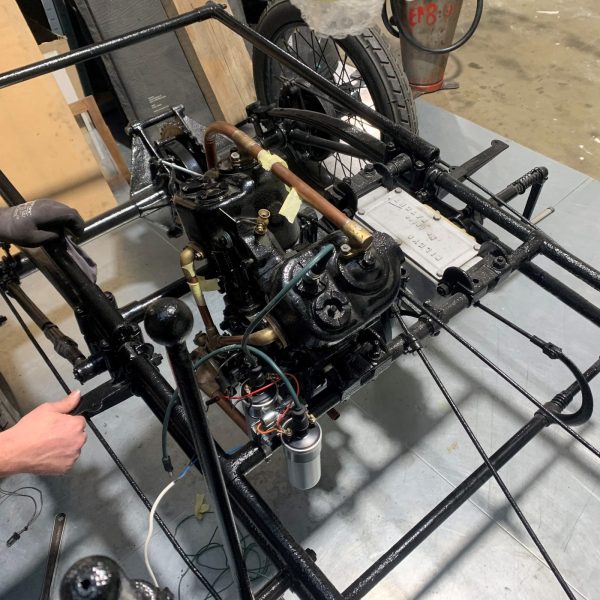
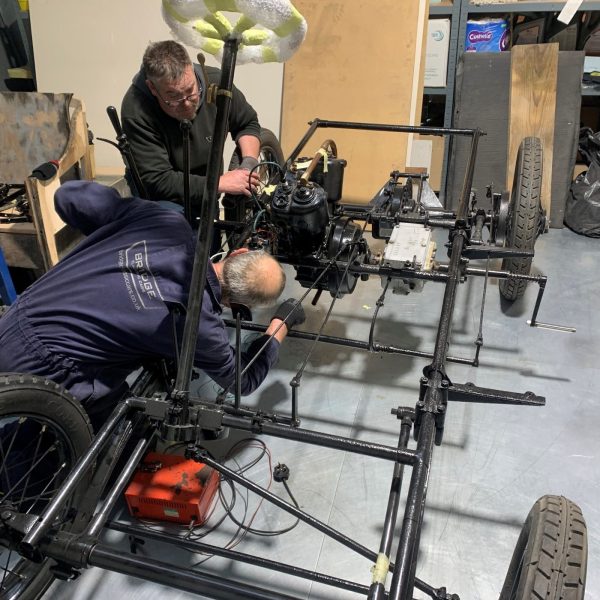

Classic car technician Dave has been continuing his work on our extremely rare 1905 Riley 9HP.
After recently trial-fitting the wooden bodywork, Dave has, once again, turned his attention to getting our Riley 9HP up and running.
Dave has installed a new (and much improved) ignition coil set up into this very special classic car. With this latest addition, our 1905 Riley 9HP continues to move closer to being started up and ready to drive once more.
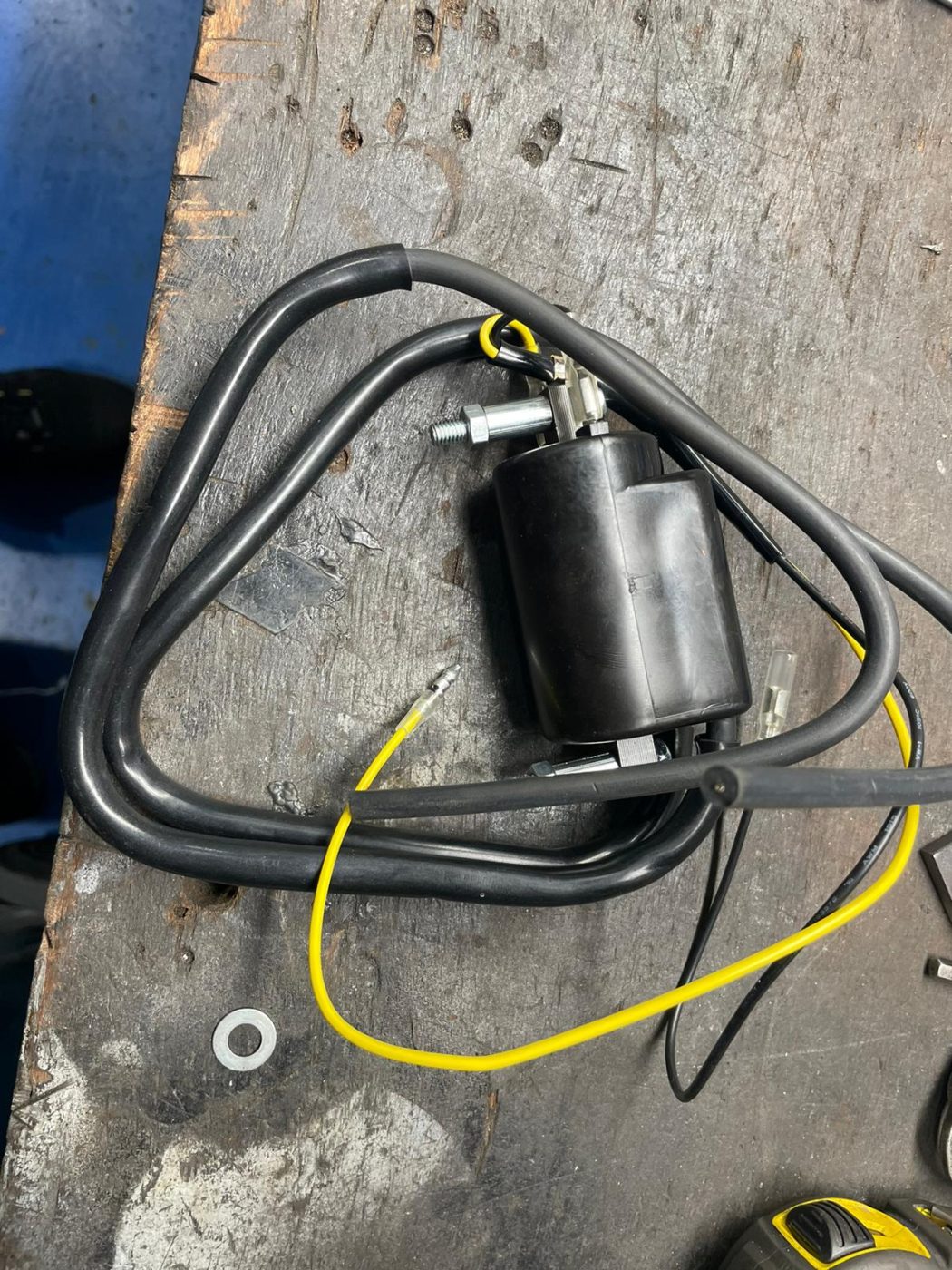
Our 1905 Riley 9HP has been going through a big transformation over the last few weeks. A big step towards this ultra-rare car looking more like it should was when the wheels were fitted. This was a great opportunity to see much more clearly how our finished Riley will hopefully look.
However, classic car technician Dave has been taking our 9HP through an even bigger stage of its transformation and restoration by trial-fitting the wooden bodywork.
This was the first time in a very long time that the bodywork and chassis were together in what is likely to be their final configuration.
While it’s still not the right time for everything to be secured into place, this trial-fitting gave everyone here at Bridge Classic Cars a clear view of how special this car truly is.
Even Dave couldn’t help himself and had to take a seat in the car he has been working so hard to bring back to life.
Obviously, there is still a long way to go before our 1905 Riley 9HP is ready to leave us, but it certainly won’t be too much longer before the sound of the engine is heard throughout the workshop.
Starting the engine for the first time in decades will be an extremely special moment and it is one we are very much looking forward to.
The photos below show just how much of an impact having the bodywork on the chassis has on the car. A huge amount of work has gone into the project to get it to this stage and it is always rewarding to see it make big steps towards its finished state.


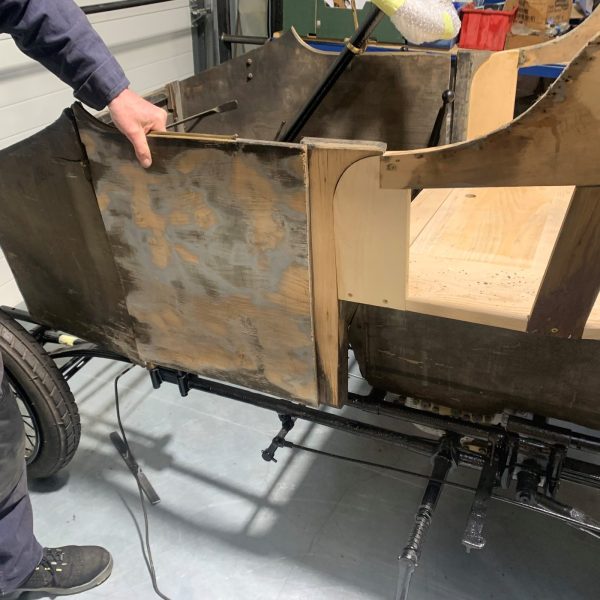
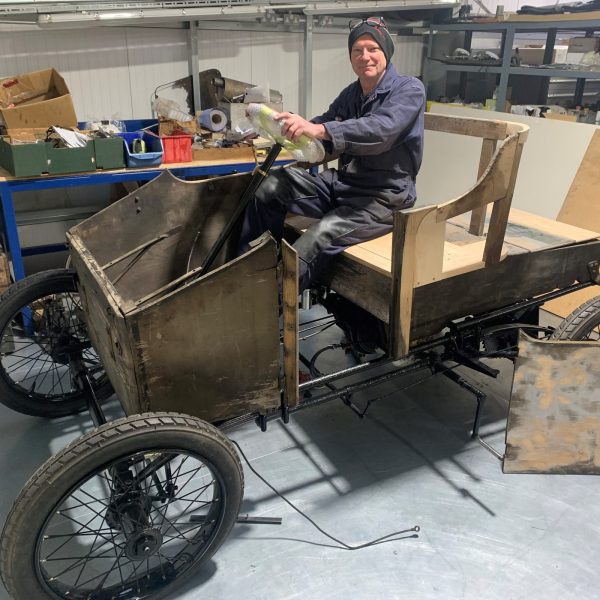
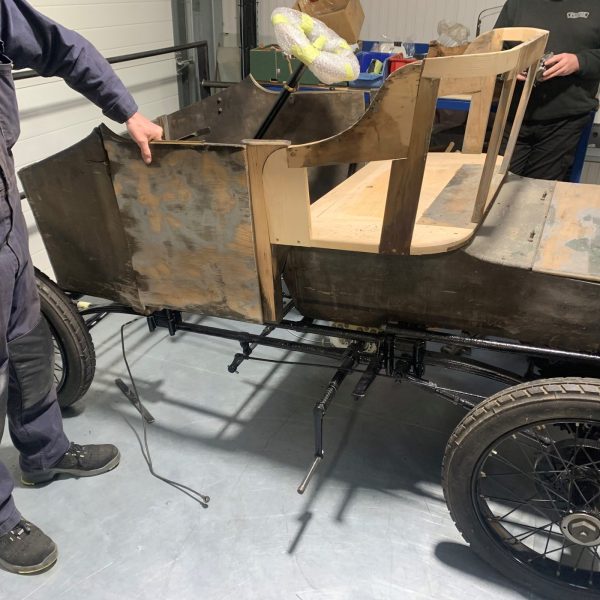
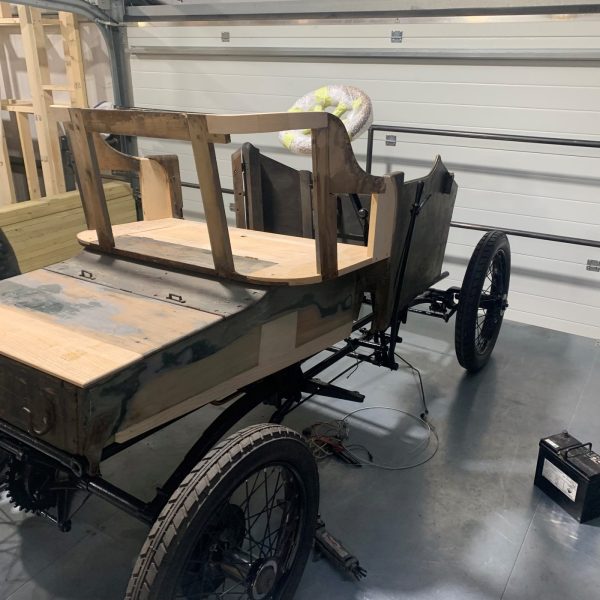
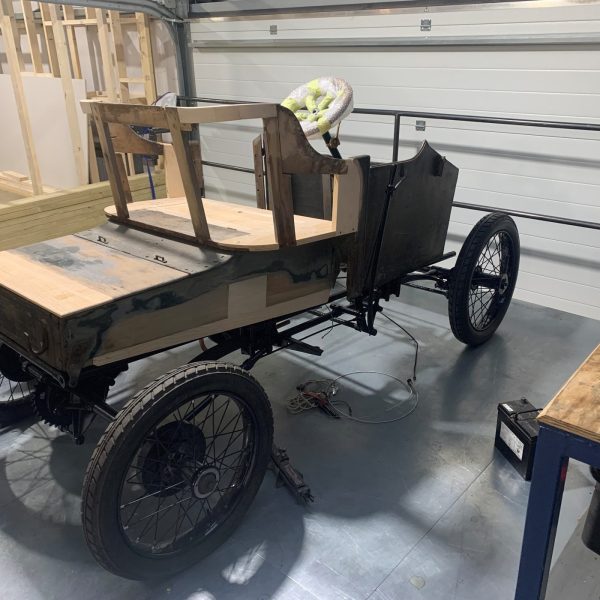

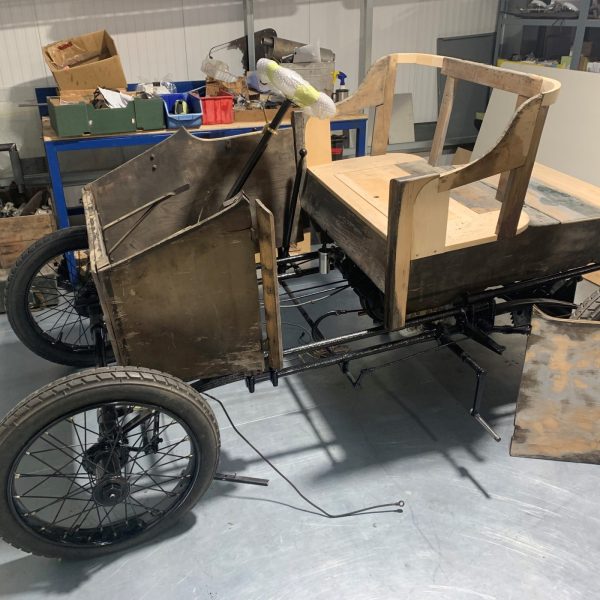
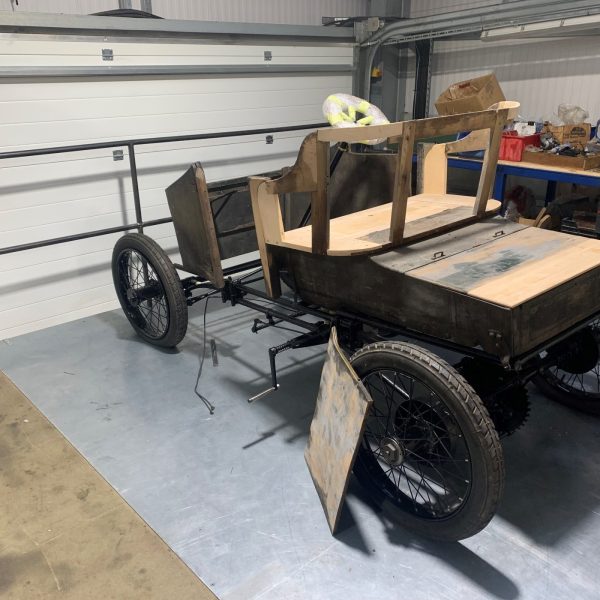
You can’t get much rarer than our 1905 Riley 9HP. With only 3 believed to be left in existence (including the one in our workshop), we understand how important it is to bring this truly classic car back to life.
Our team of highly skilled classic car technicians have been working hard to rebuild our 9HP and, despite numerous setbacks and challenges, progress is still being made in the restoration of this more-than-a-century-old car.
Classic car technician Dave has been continuing work on our 1905 Riley 9HP.
He has recently added the wheel hub nuts and the nut locking ring. As work continues on this truly classic car, it has already come a long way since it first arrived at the Bridge Classic Cars workshop.
With quite a bit of work still to do though, the whole team here are excited to see this car back in its original state and ready to head outside for its first drive in a long time.

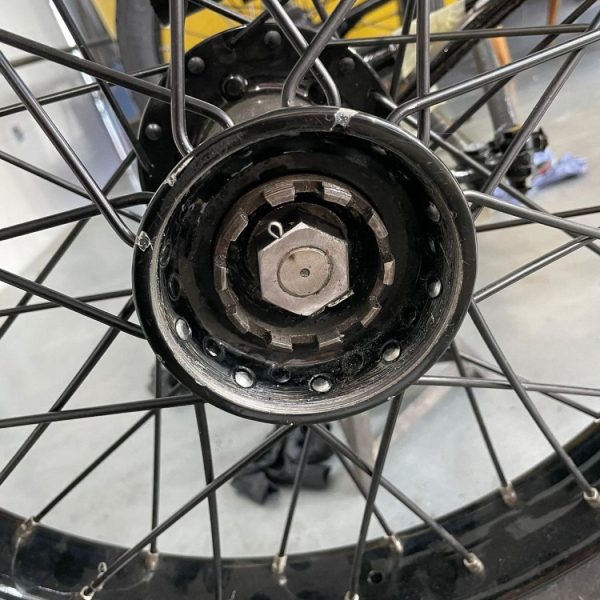
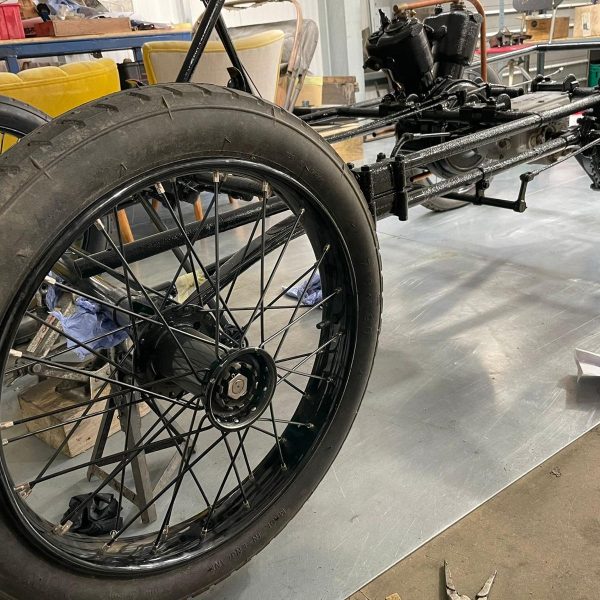
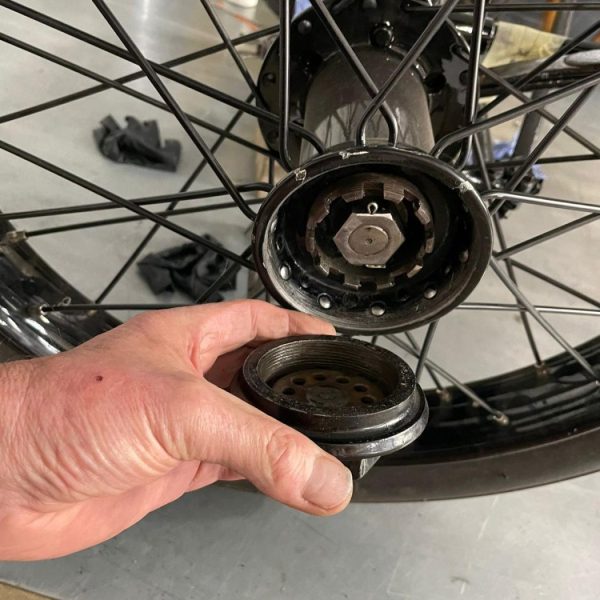
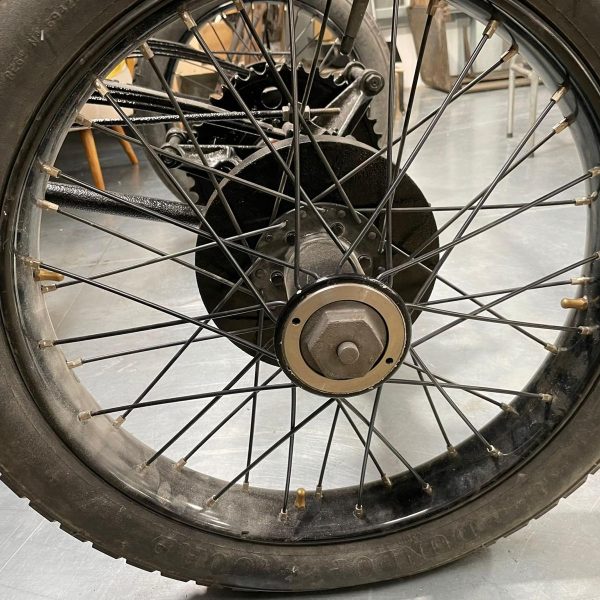
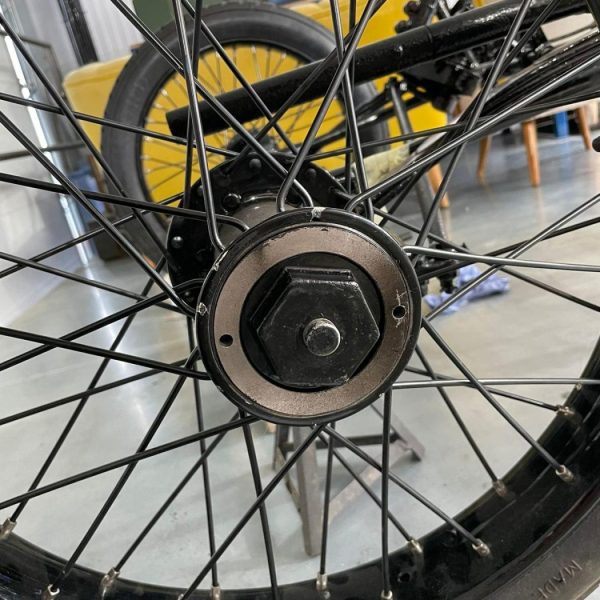


Our 1905 Riley 9HP looks very different to how it looked when it first arrived at the Bridge Classic Cars workshop.
Working from photos, drawings, and a whole lot of skill, our classic car technicians have been making progress on the restoration of this ultra-rare car.
Recently, the wheels have been attached to our 9HP making it look just a little bit more car-like. While there is still a long way to go before it can be driven out of the workshop, the addition of the wheels certainly does a good job of showing how far things have come with this classic car.

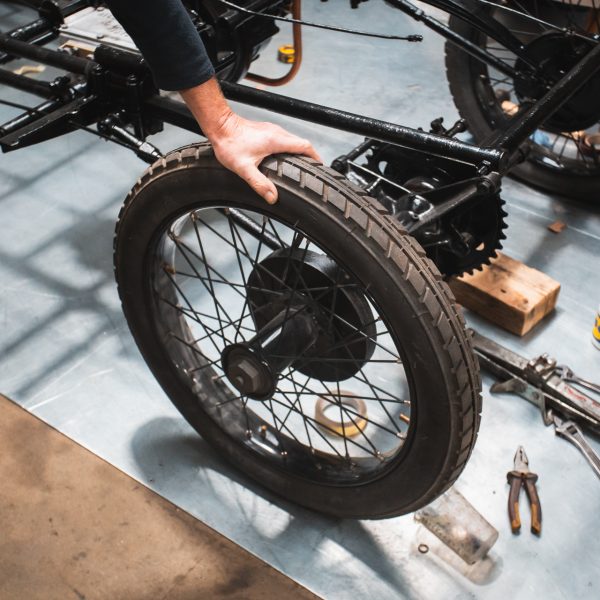
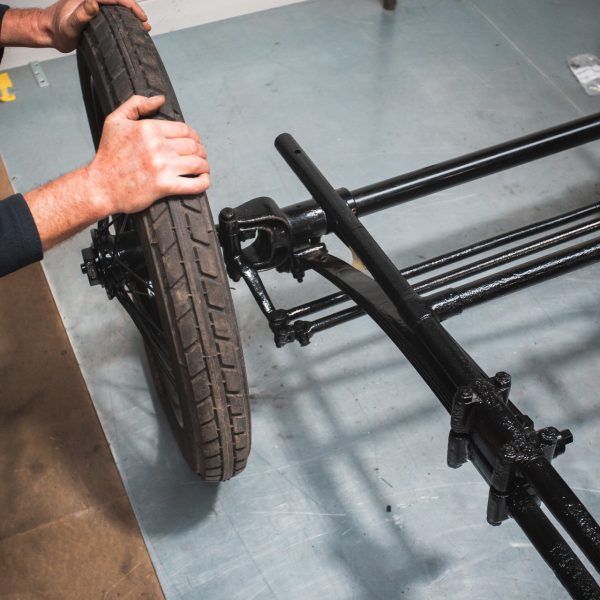


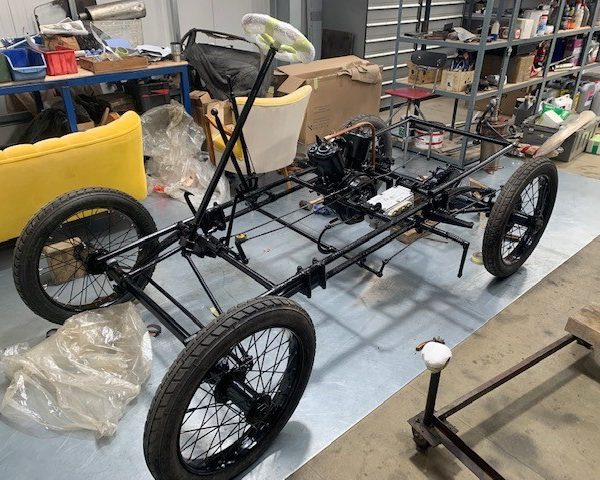
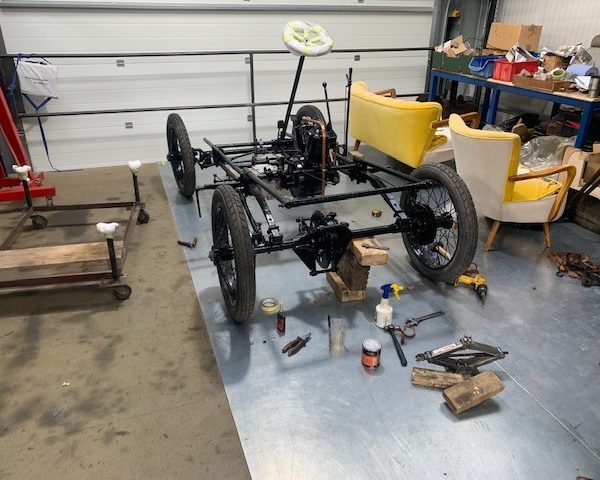
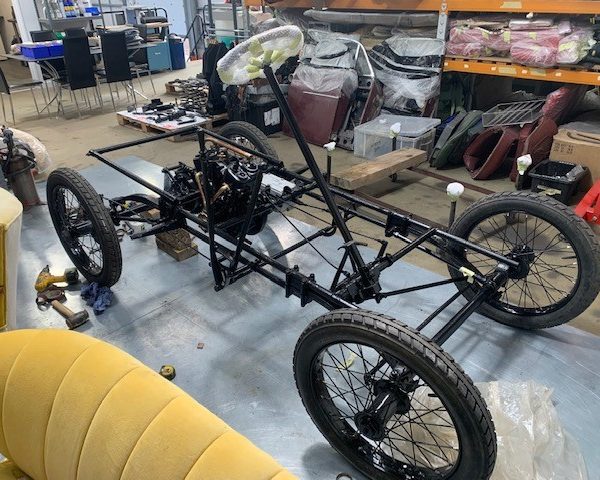
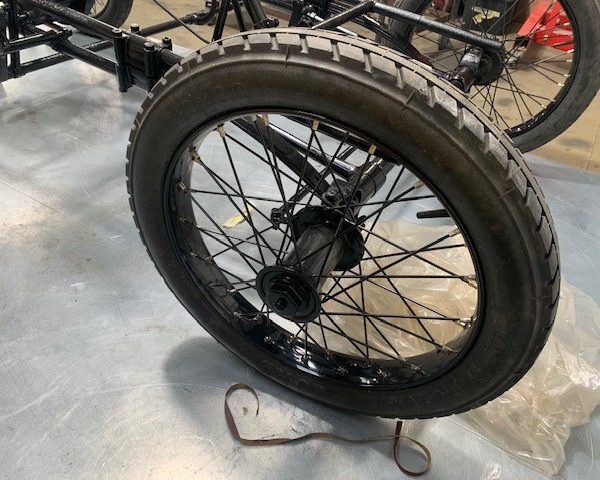
Our 1905 Riley 9HP has been in the Bridge Classic Car workshop for quite some time now. Restoration work on a car like this is extremely complex and can only be done by expert classic car technicians.
Dave has been putting his close to five decades worth of experience to good use by getting more work done on this truly unique car. If you haven’t heard the story of our Riley 9HP before, then it’s one you should definitely make yourself familiar with.
Firstly, the fact that there are believed to be only 3 of these cars left in existence should be enough to grab the attention of any classic car enthusiast. One of the remaining three is in the Gaydon Motor Museum, one is thought to be in a private collection, and we have the third in our workshop which is the one Dave has been working on.
Initially, our 9HP was missing a radiator. While we searched for a way to source something that could be used as a replacement, we were extremely fortunate to be offered an unbelievably rare Riley 9HP radiator that had been found during a house clearance. Not only was this radiator a match for our Riley, but it was actually very likely the radiator that had originally been in the car.
While we may have had some good luck with the radiator, the rest of the Riley has been much more challenging to restore. As there are only 3 left, there are only 2 others we could potentially look at in order to see how the finished vehicle should look.
We were offered the opportunity to visit the Riley 9HP in Gaydon Motor Museum which we took and were able to get a whole load of photographs that would hopefully help us rebuild this incredible car. It’s these photos that Dave has been using as a reference to try and bring everything back together in its original form.
Relying on photos and a wealth of experience shows how skilled our classic car technicians really are. There aren’t too many people out there who could take on this type of work but, fortunately for us, we have experienced technicians like Dave who are determined to get the job done.
The most recent work Dave has completed on the car was making the water return pipes from the cylinder head, fitting the front stub axles with bearings, along with fitting the anti-tramp bars too.
It’s worth repeating one more time that our 1905 Riley 9HP is one of only 3 left in existence. We have one of the last remaining examples of this truly classic car and we look forward to seeing what the future holds for it.
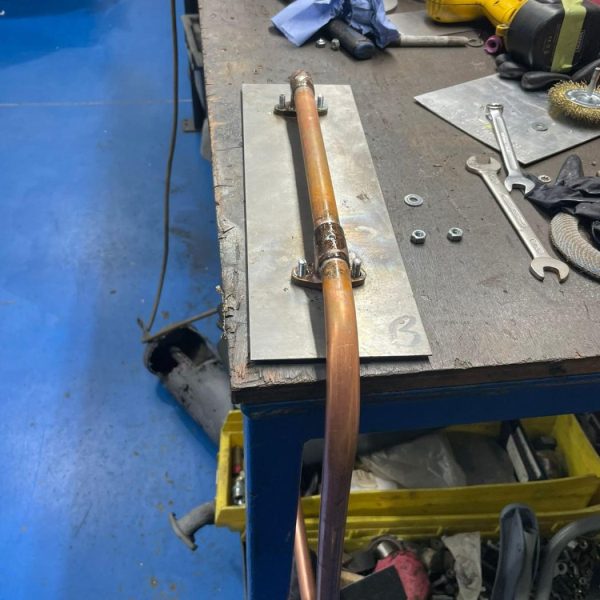


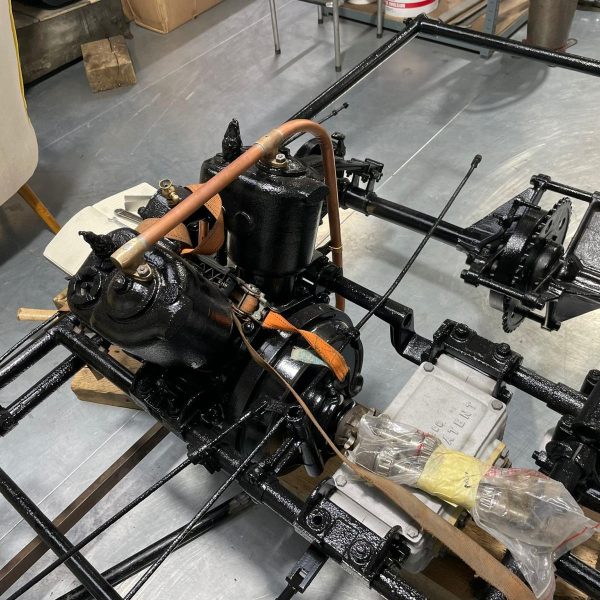
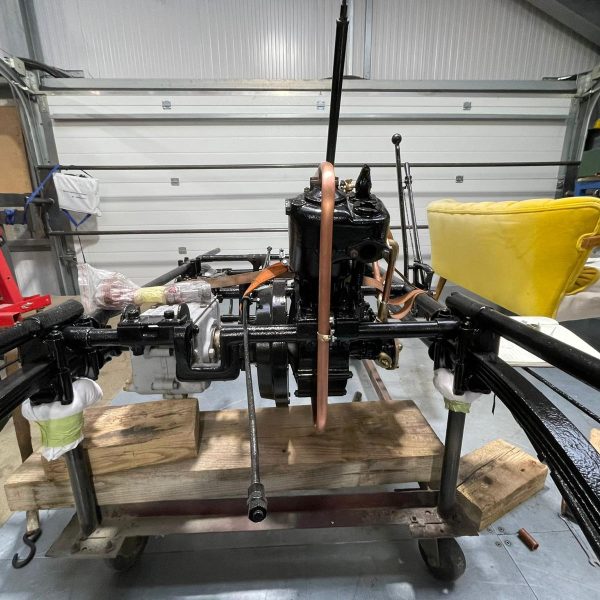
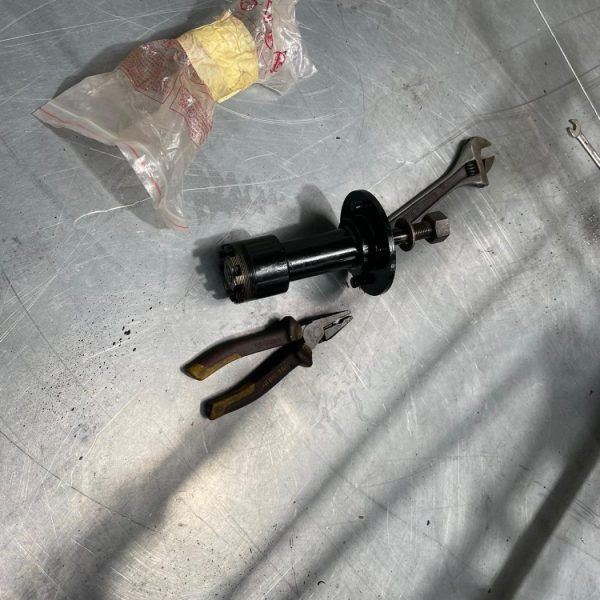
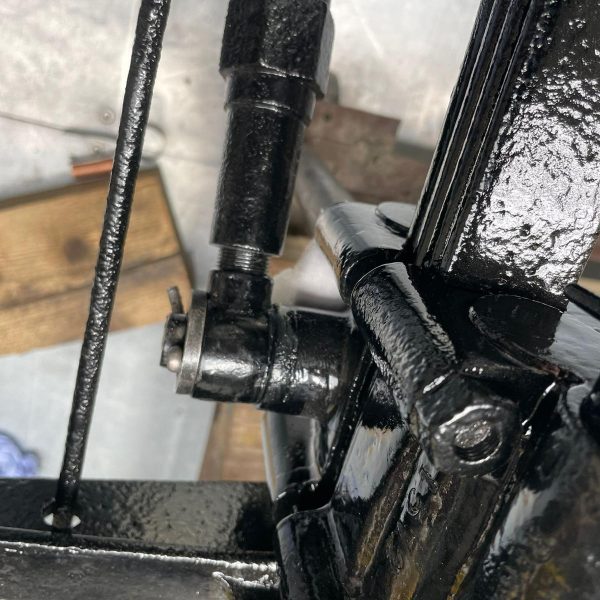
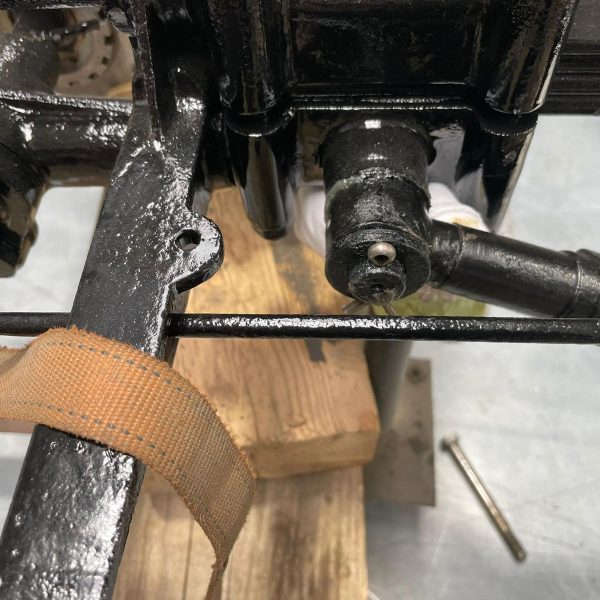
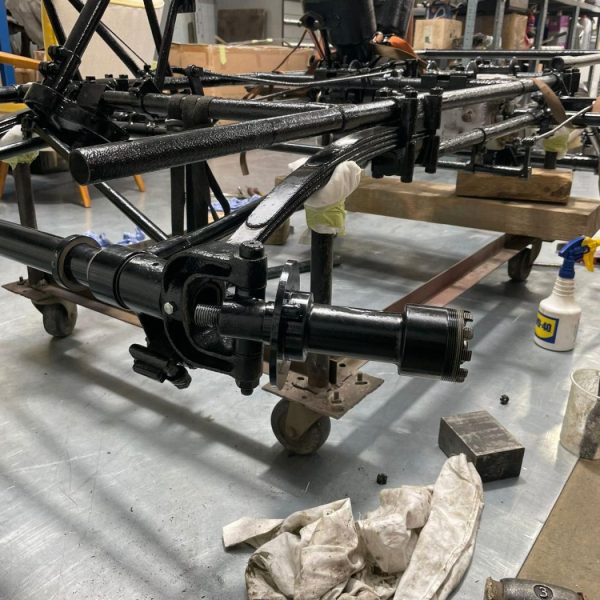

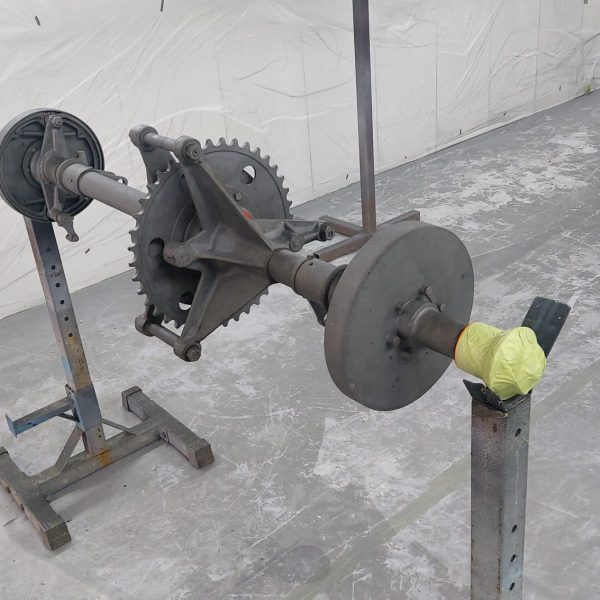


The paint shop at Bridge Classic Cars have prepared and painted the rear axle assembly for our 1905 Riley 9HP restoration project.
Since returning from the blasters, the paint team have been getting all of the bare pieces into the spray booth to be finished in gloss black, the same as the rest of the frame. This will be left to cure properly before being reunited with the rest of the prewar tourer.
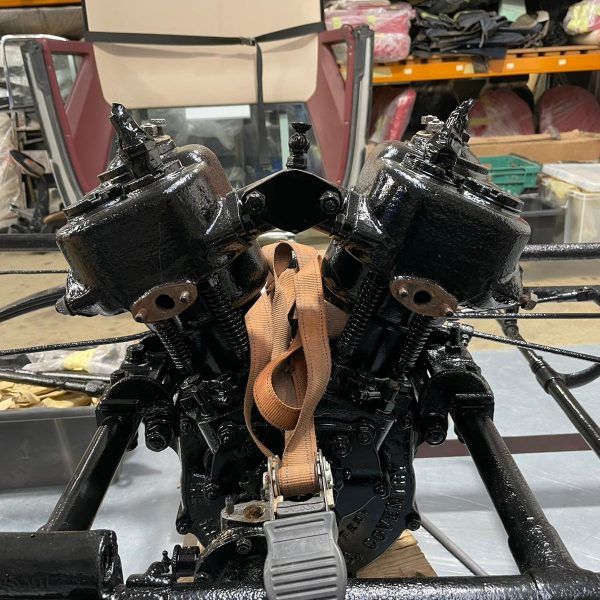

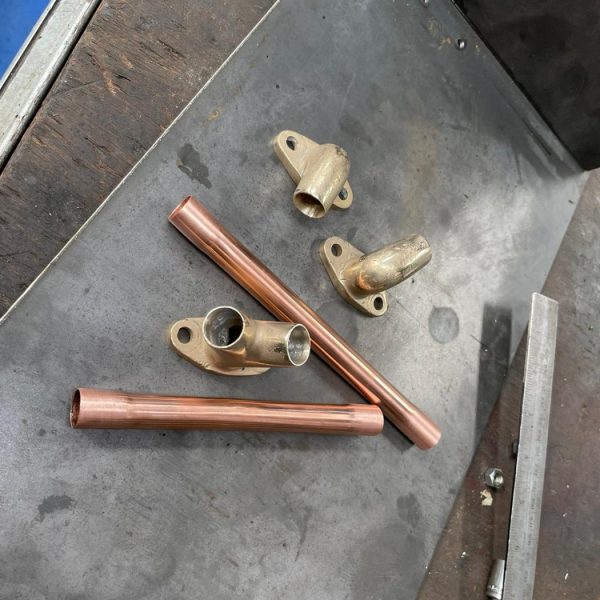
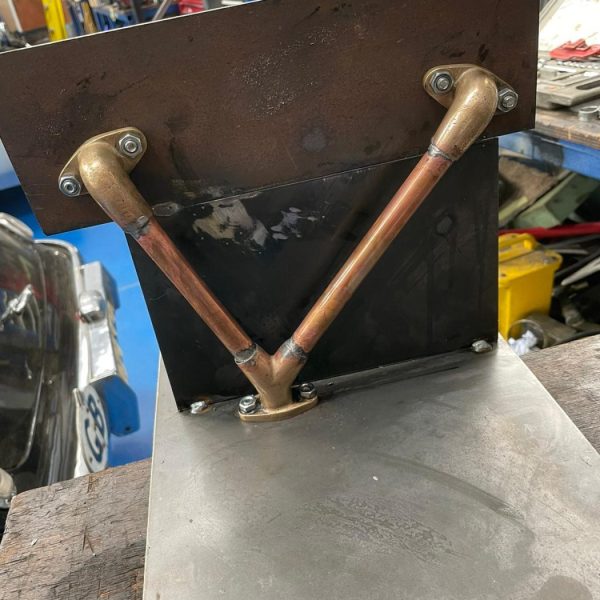
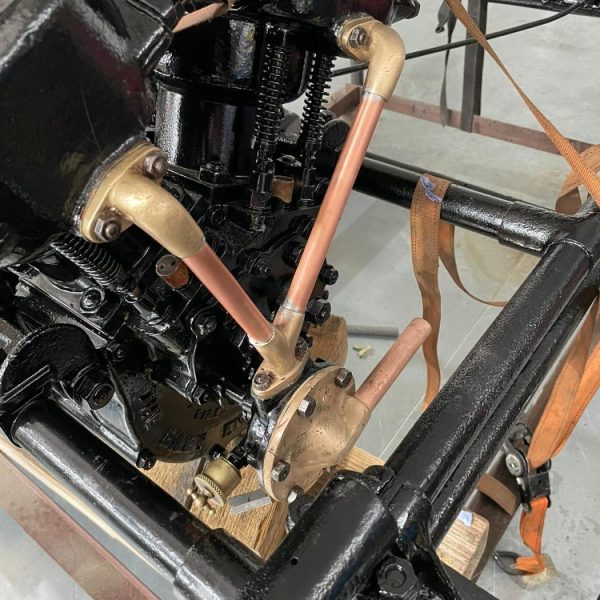
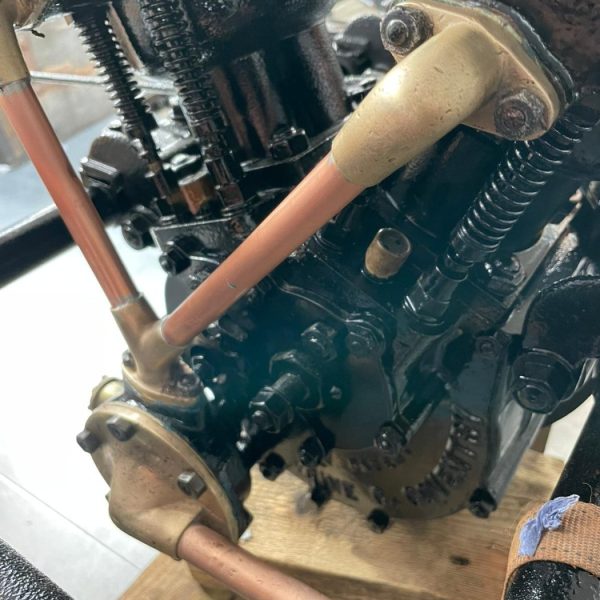

The restoration team at Bridge Classic Cars have been working hard on recreating the coolant system on the 1905 Riley 9HP.
Our technician Dave has been busy carefully making up new coolant pipework for the 117-year-old tourer. These are being made from brass and copper, as it would have been originally. For this, Dave removed the water pump from the engine block after taking countless measurements in order to create a jig that meant Dave could more accurately solder the entire piece without worrying about it moving.
After this, everything could be test fit back onto the car. Dave remade the now long-gone gaskets by hand before the pipework was tested and then painted in the glossy black.
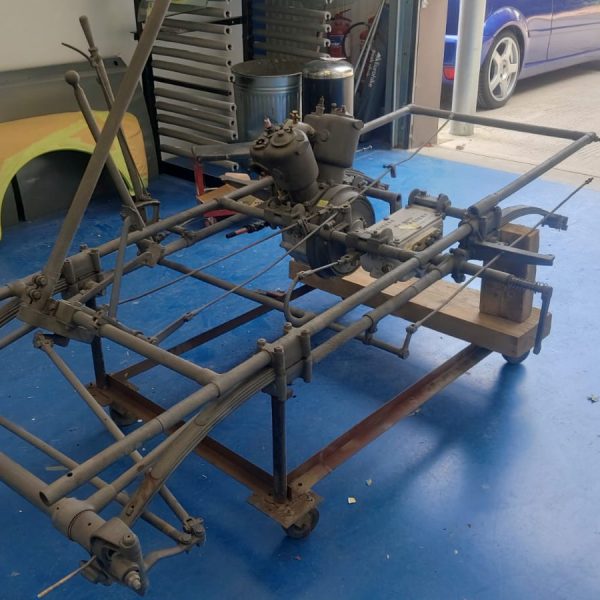


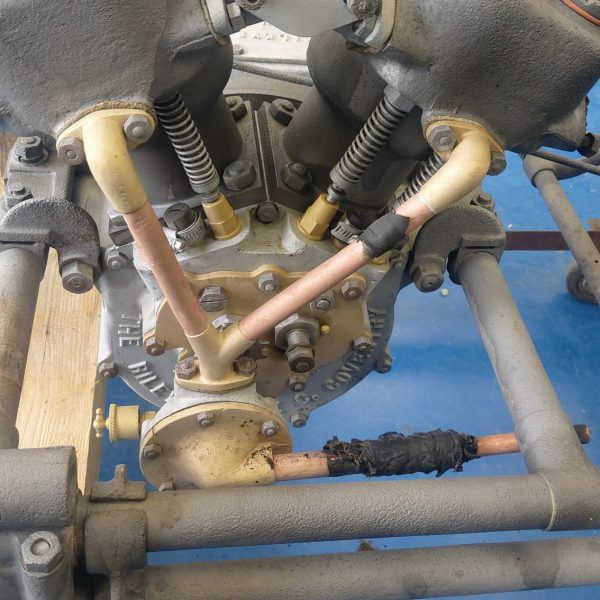
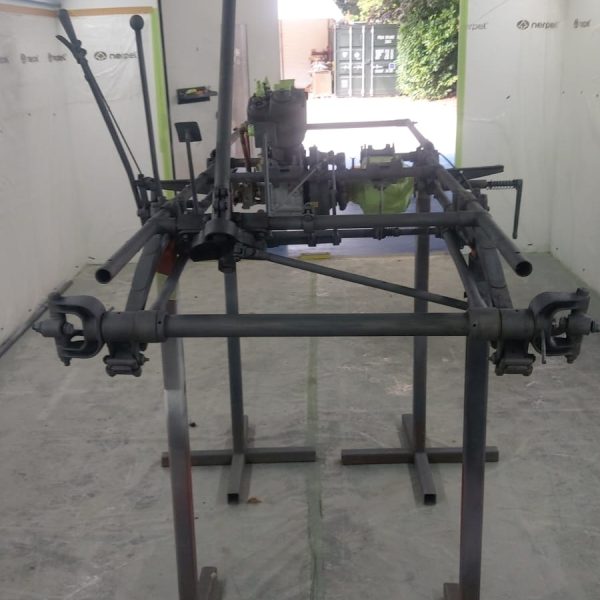
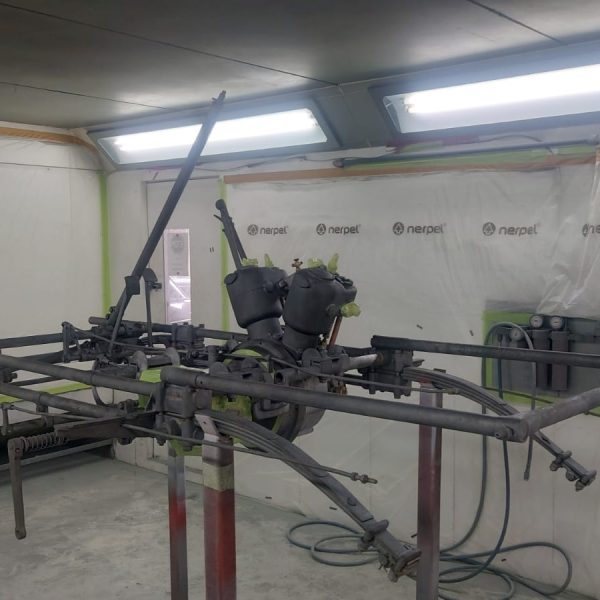
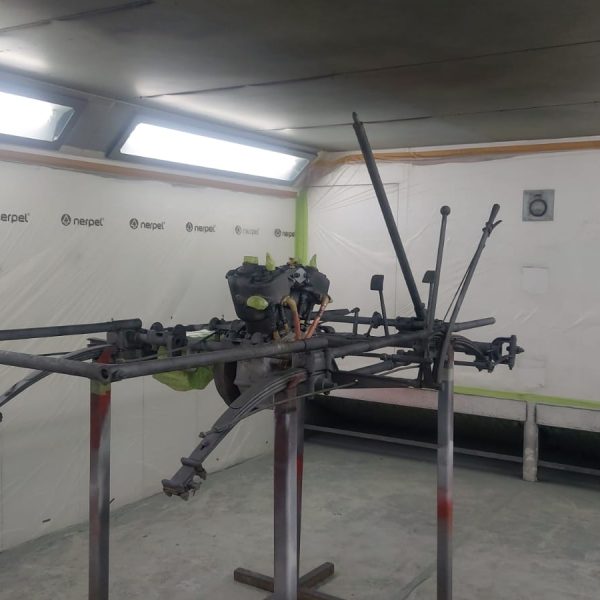

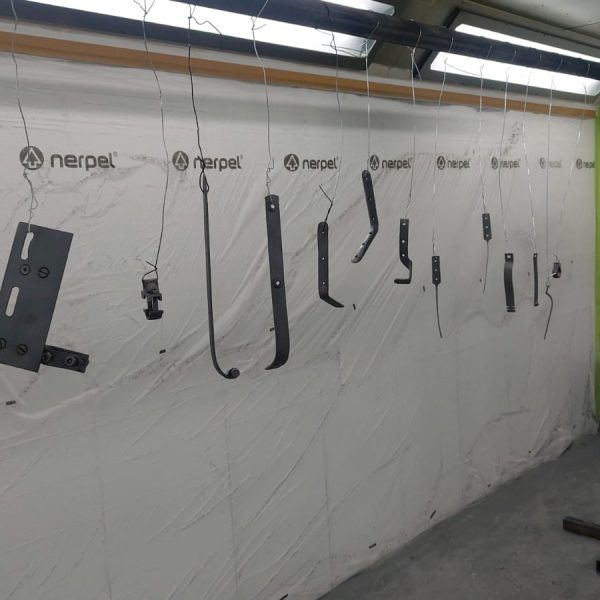

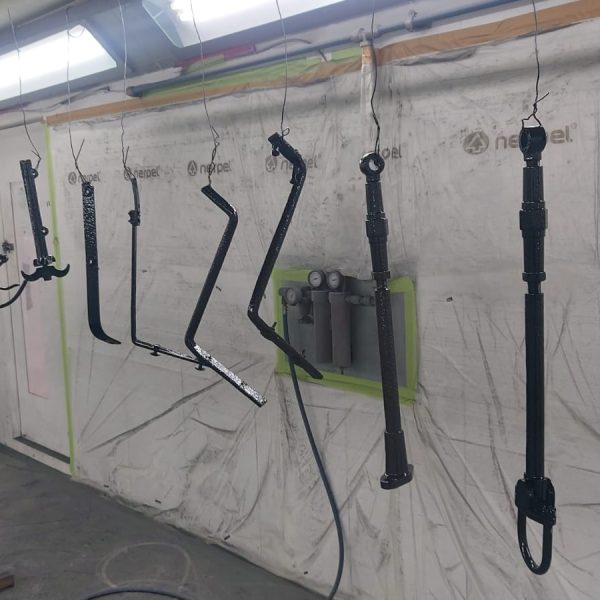
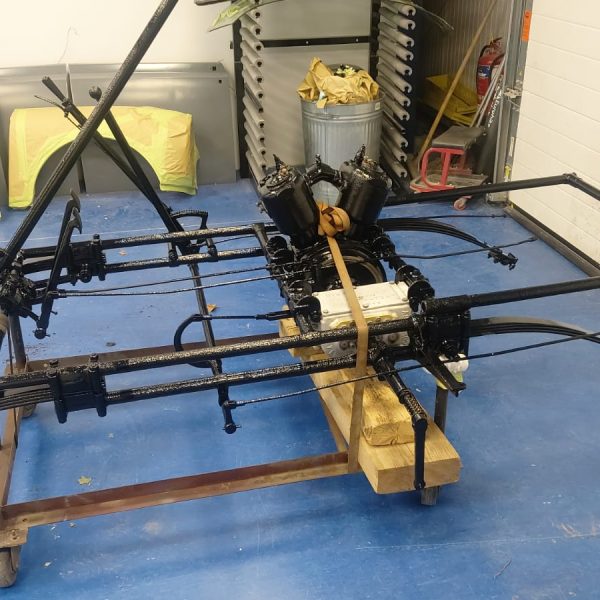

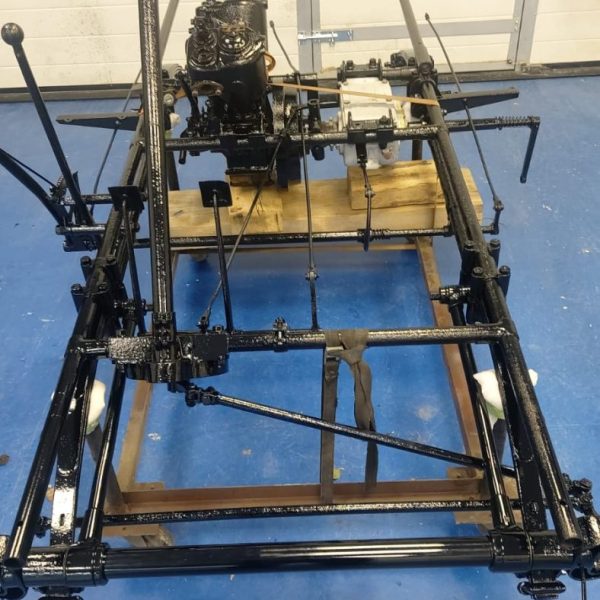
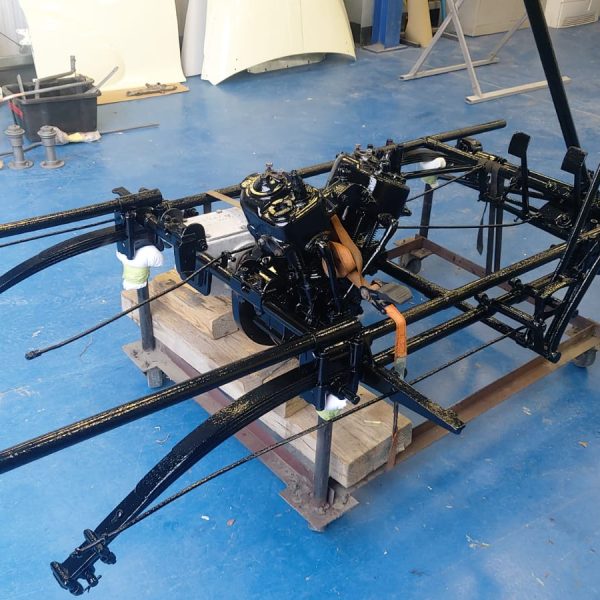
The chassis and engine from the 1905 Riley 9HP has recently been delivered back to the Bridge Classic Cars Suffolk HQ after being blasted by local specialists.
After being brought back, the paint team thoroughly cleaned down every part before taking it into our in-house paint booth. The team then set-up the system to finish the whole unit in a beautiful gloss black as it would have been originally.
We’re excited to see the restoration of the 1905 Riley 9HP progress even further very soon!
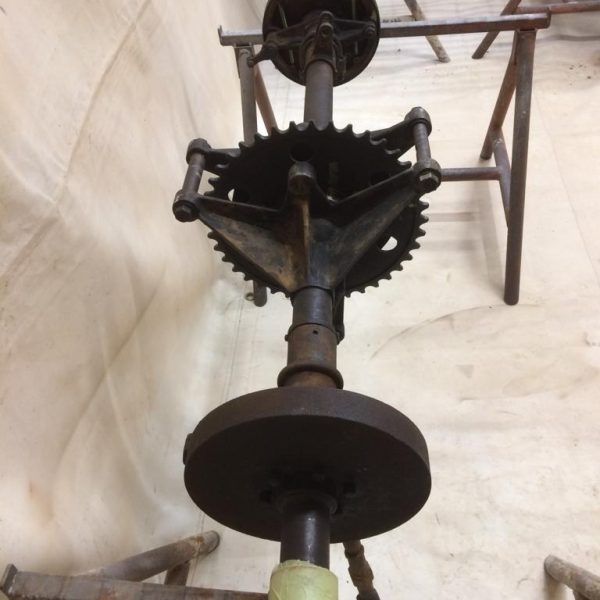
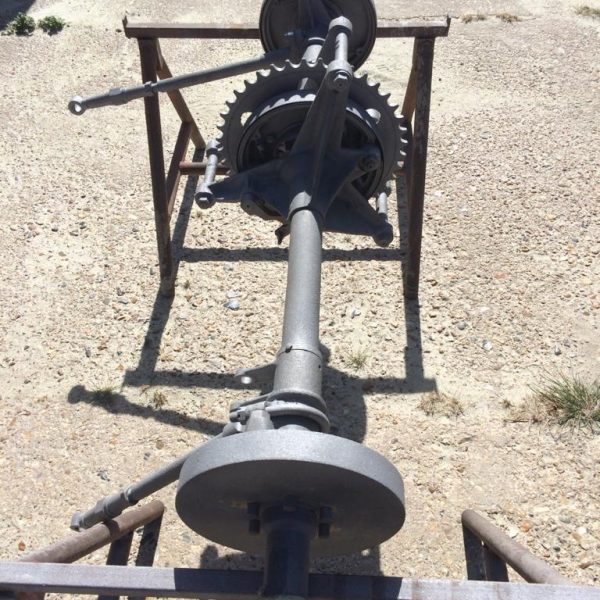
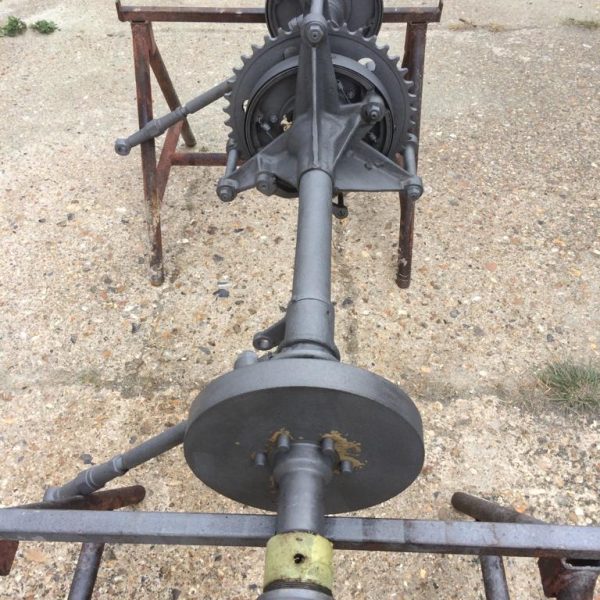
The rear axle and differential on the 1905 Riley 9HP is on their way back to the Bridge Classic Cars workshop after being sent away for blasting.
The process that was suggested would preserve some of the 117-year-old Patina and help to show the originality of the car.


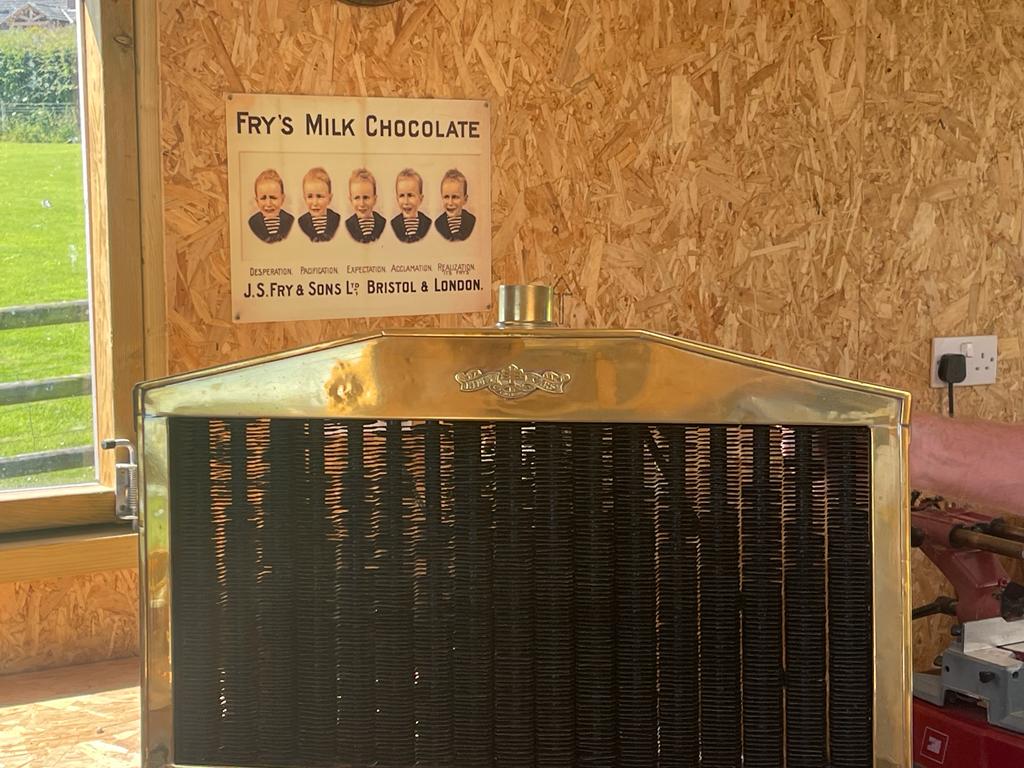
Friend of Bridge Classic Cars, Carl, has been down to pick up the restored radiator for our 1905 Riley 9HP from Newquay for the project.
The radiator, which was found during a house clearance, was taken to Newquay Radiators to be restored and reworked so it’s as good if not better than new. This is a massive piece of the restoration journey for 117-year-old Riley and we’re excited to start getting everything back together!
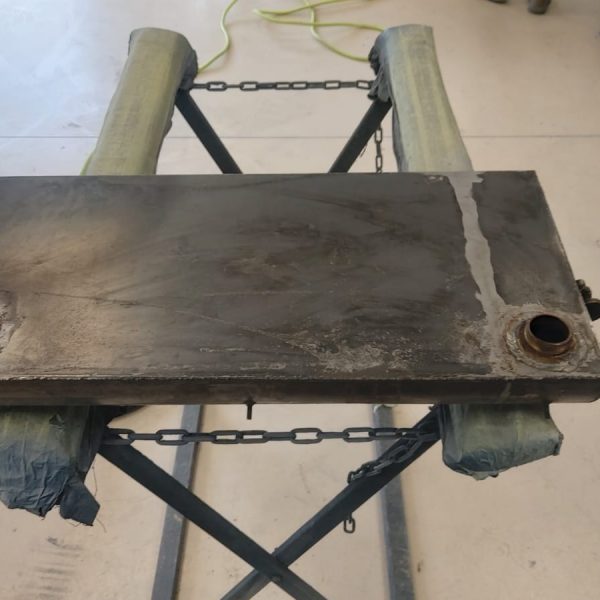
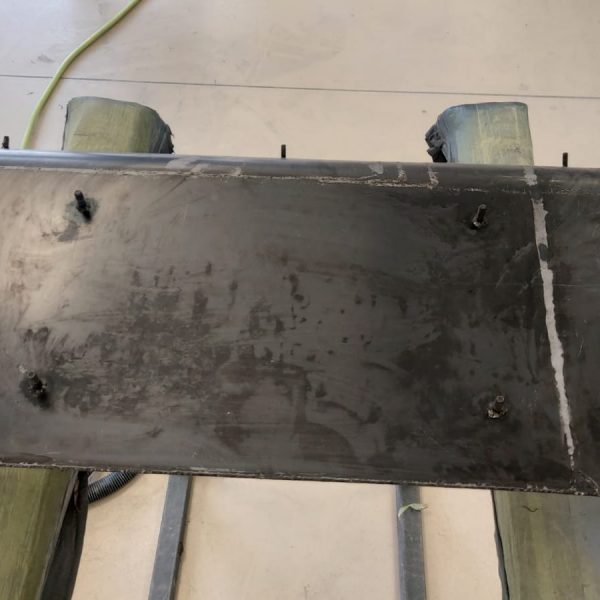
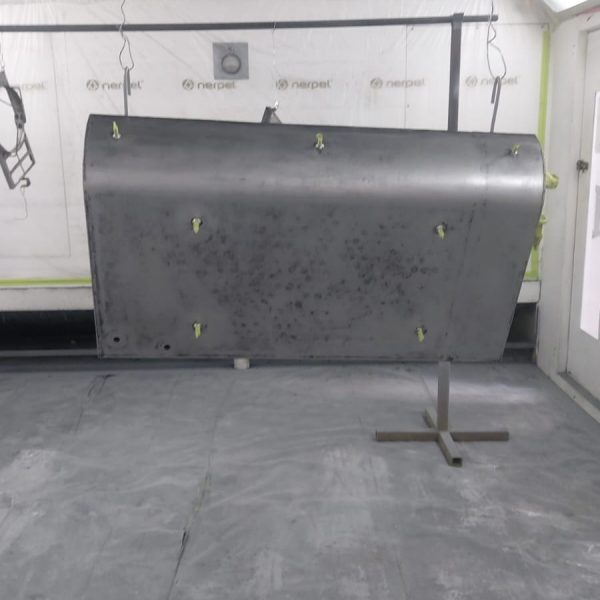
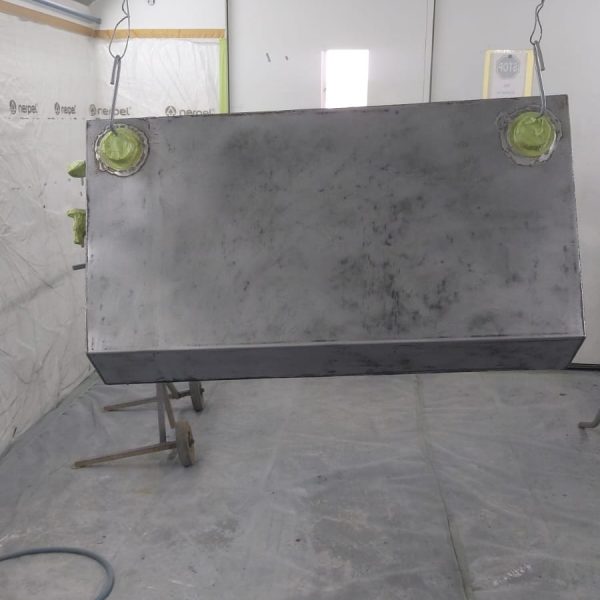
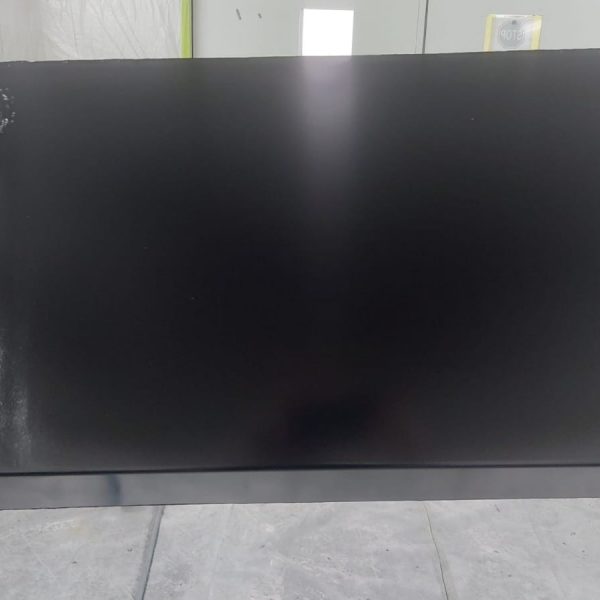
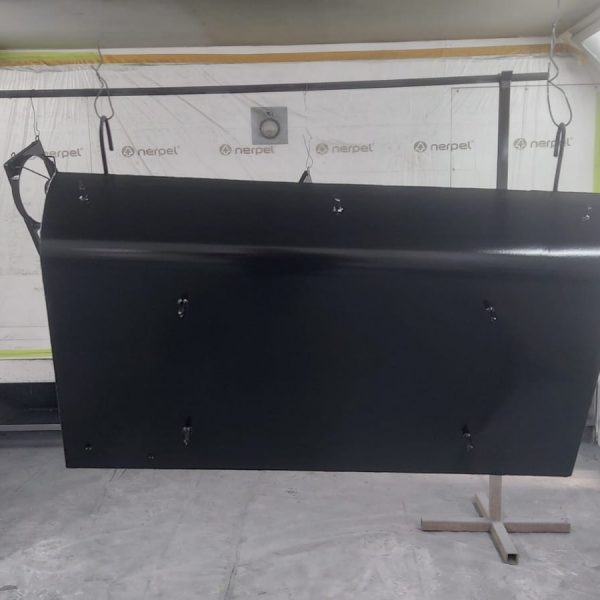
The paint shop at Bridge Classic Cars have painted the restored fuel tank of the 1905 Riley 9HP as part of its restoration.
The team cleaned down the recently restored and tested fuel tank before painting it satin black to go back on the car.
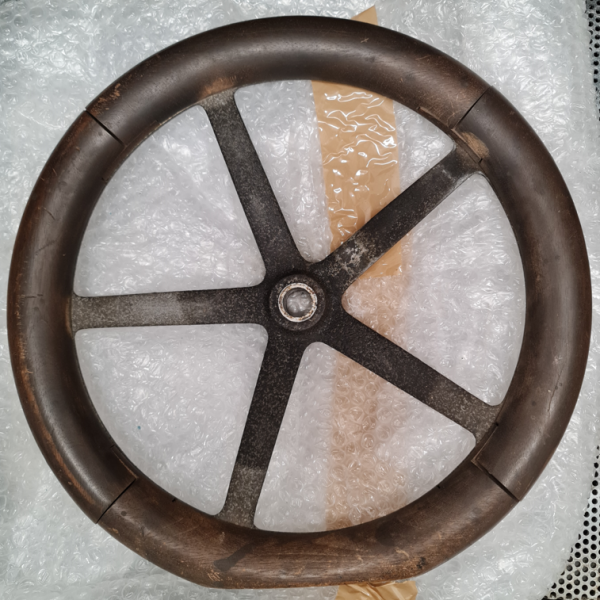
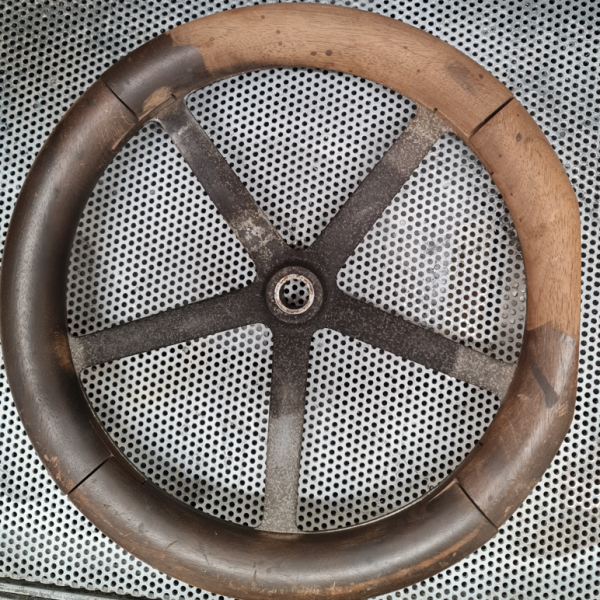
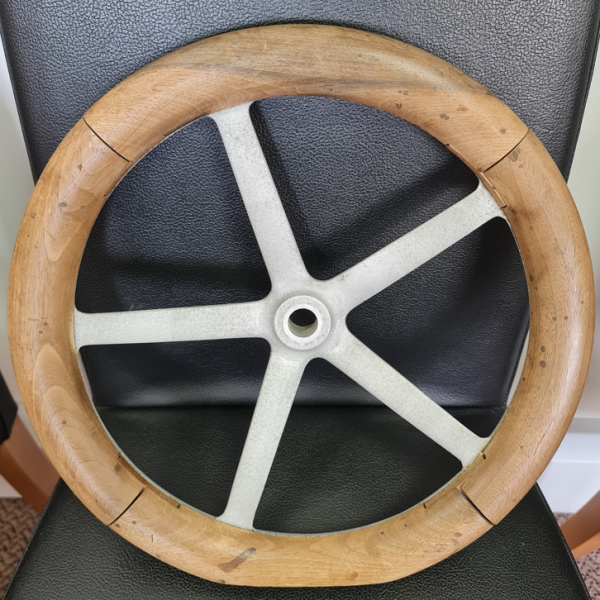
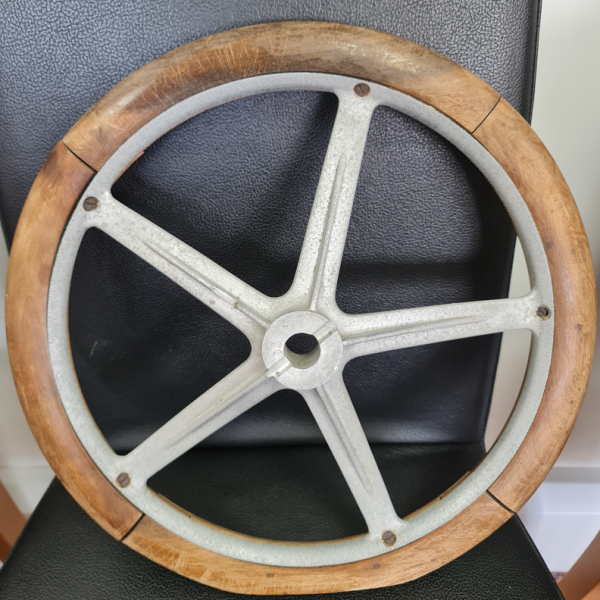
Our 1905 Riley 9HP has had its steering wheel removed by the workshop team here at Bridge Classic Cars to be sent off for a new cleaning process specifically made for delicate or antique parts. The steering well was sent to Re-Go Auto Parts in Kent where the team could carry out the process.
The original steering wheel shows 117 years of ageing across the wooden and metal surfaces of the piece. With a new process of Laser cleaning, the team could be extremely precise with just where and how strong the laser was. They cleaned up the main spokes of the steering wheel with a relative high-powered pass to clean off the steel but made sure that the power was turned down when passing over any softer materials like the aluminium.
The wood wasn’t touched by the laser. This was hand-cleaned by the team at Re-Go to bring it back to as close to the original as possible.
It looks absolutely incredible and we cannot wait to get it back to our Pettistree workshop to have a proper look at it.
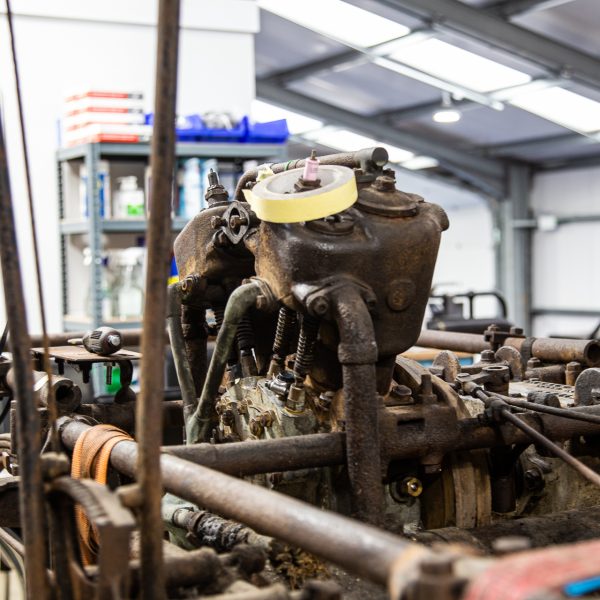
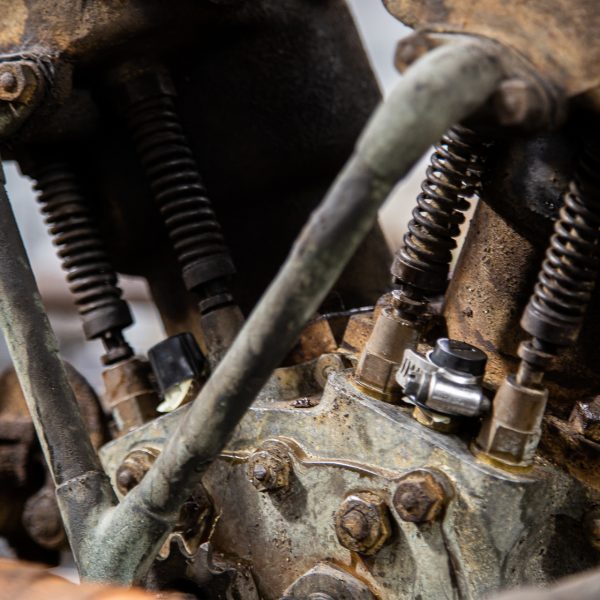
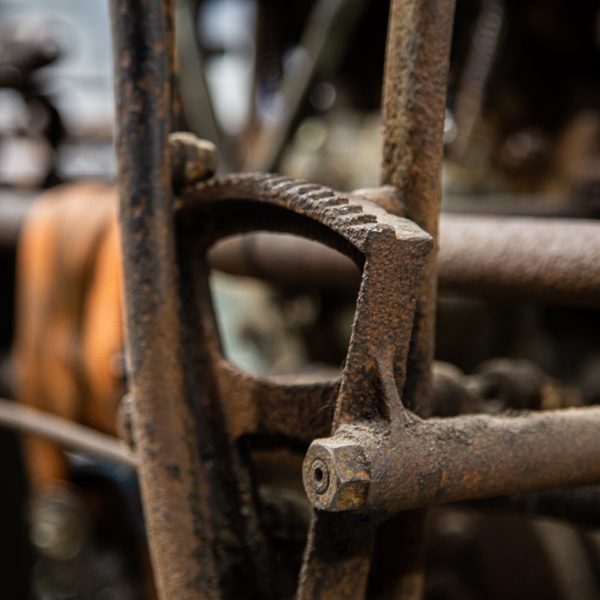
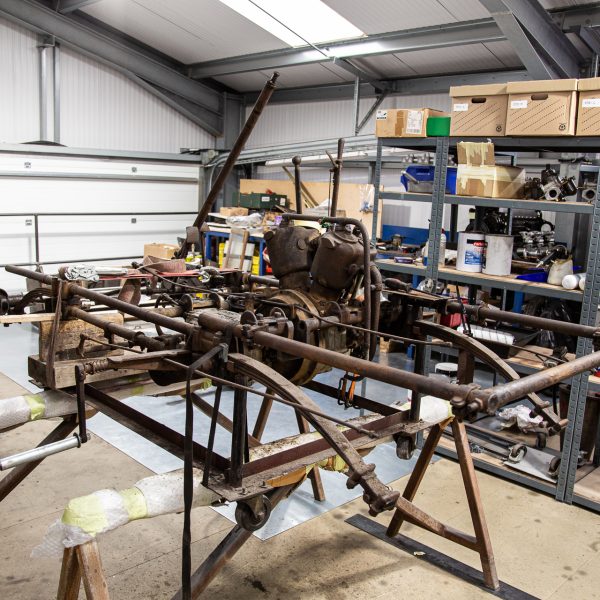

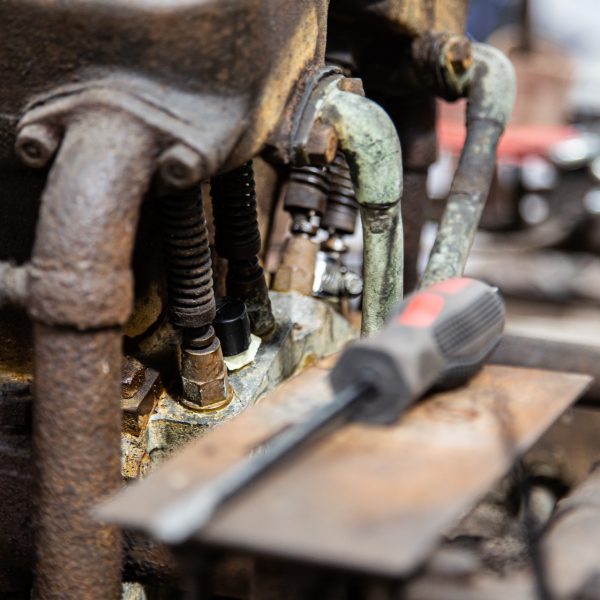



The workshop team at Bridge Classic Cars have been working on preparing the 1905 Riley 9HP for the next stage of its restoration journey.
Our technician Dave has been capping off any openings in the engine block or gearbox case after removing the entire rear axle and differential from the pre-war antique Riley. Then, Dave could move on to removing any small fixings and cappings which are too delicate to withstand the media blasting process.
The choice of blasting shot material is going to be plastic as this has been selected for the nearly 117-year-old metalwork due to not being as extreme or harsh on the material.
We can’t wait to see the frame and all the metal parts return for the car! So, keep an eye out here on the Bridge Classic Cars news page for more updates very soon.



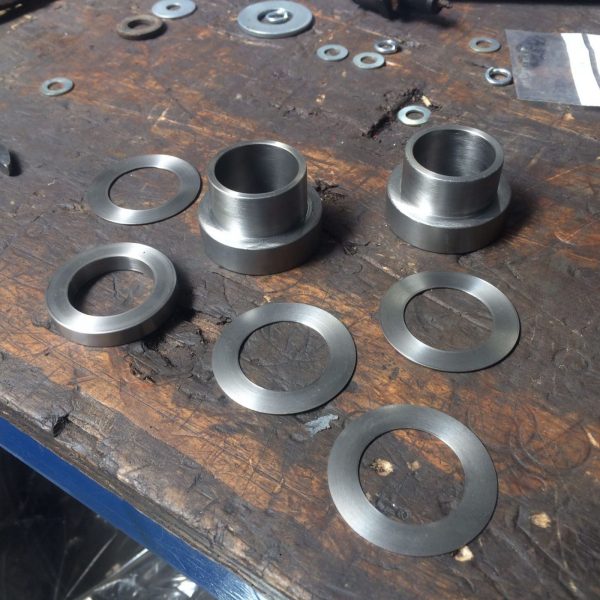




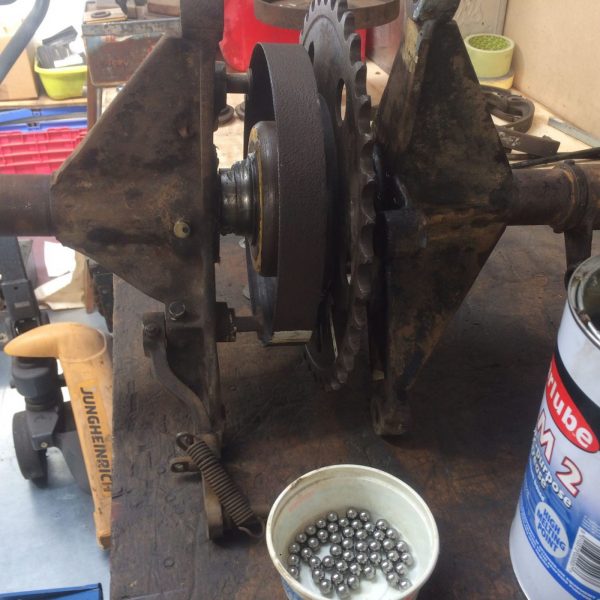

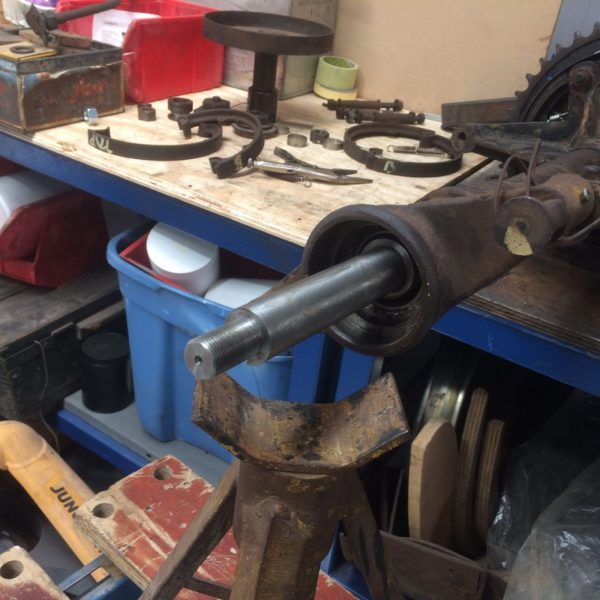
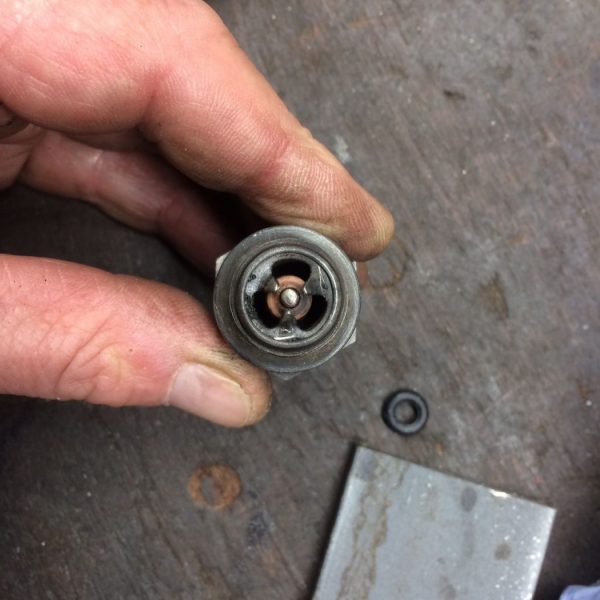
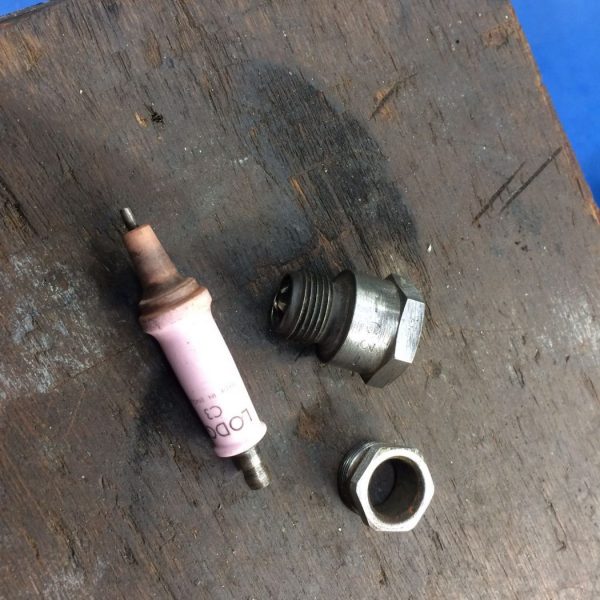
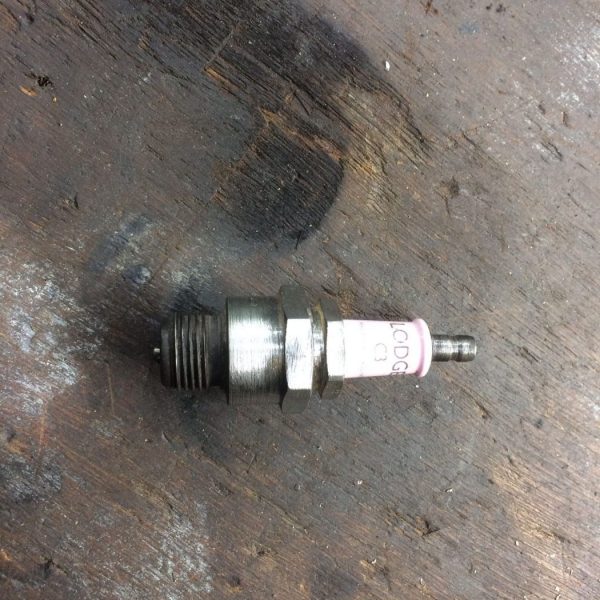
The 1905 Riley 9HP has had its rear differential and suspension pulled off the chassis to be moved to the workbench for the Bridge Classic Cars workshop to rebuild/refresh.
After testing last week, the team pulled the pieces from the chassis to pull apart and rebuild. The rear differential has had new ball bearings and races put in and everything cleaned up and regreased. The rear swing arms were also pulled out to be inspected and the mounting holes redrilled and cleaned for the new shackle bolts to slip through with no binding.
Finally, the team have been working on the spark plugs for the car and inspecting the correct gaps and spacing on the new adapter.
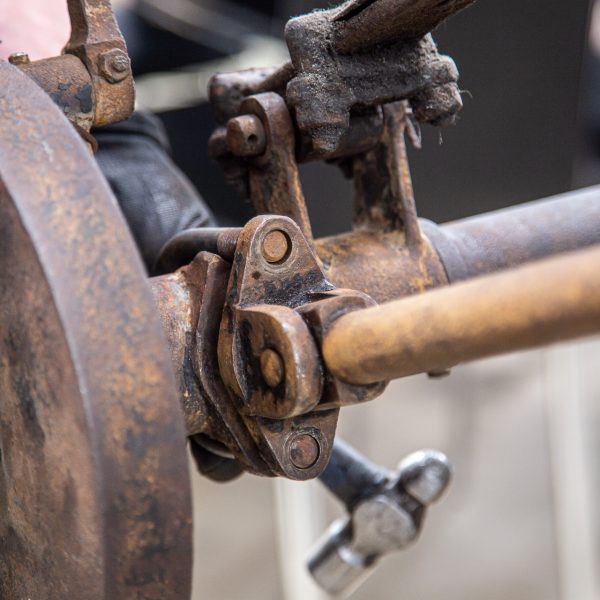
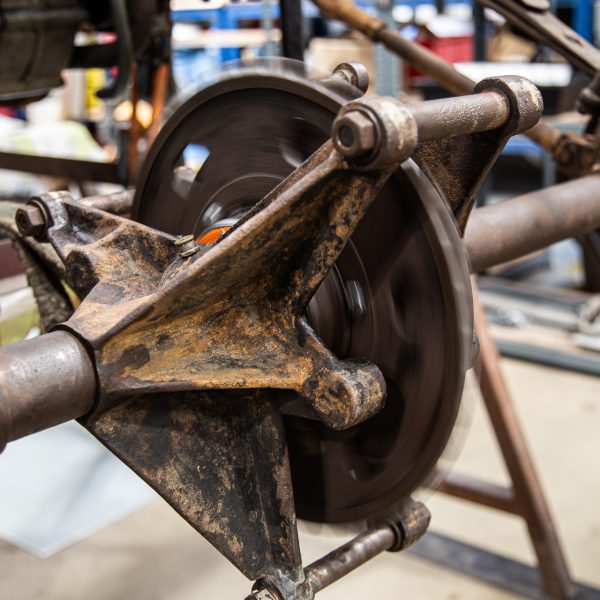
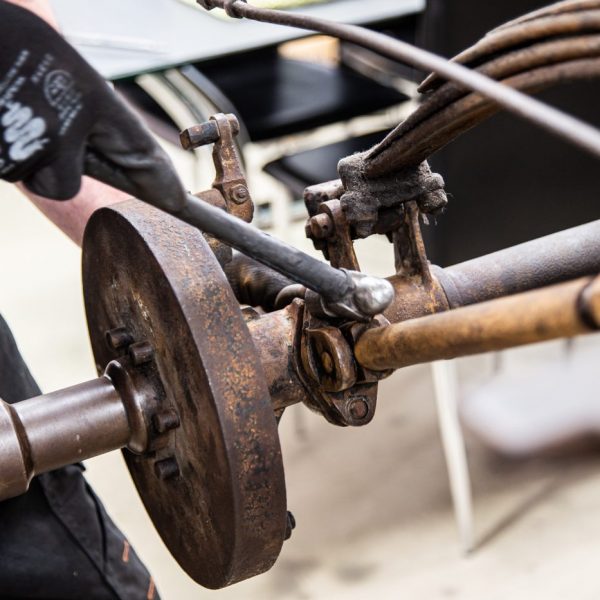
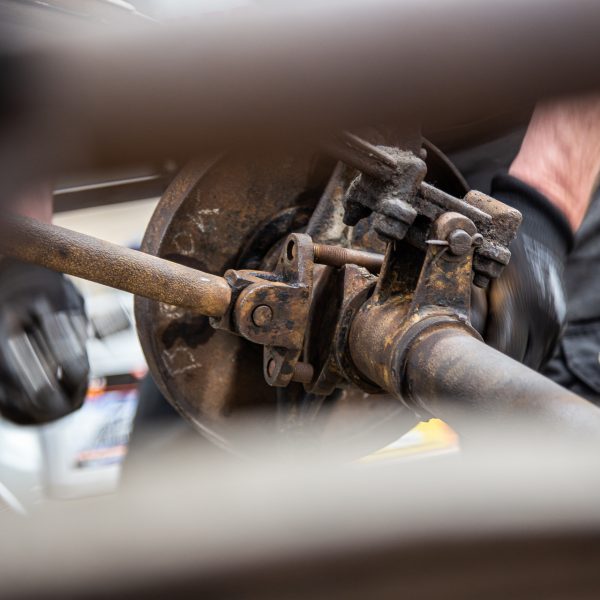
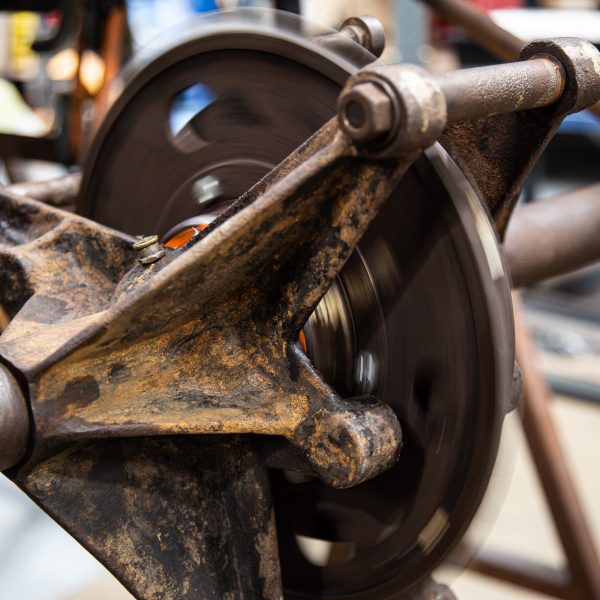

The workshop team at Bridge Classic Cars have begun the process of test fitting and aligning the original rear axle into the chassis of the 1905 Riley 9HP.
Dave, one of our technicians, has been trying to get the shackles around the axle in order to test fit the mounts to the trailing arms. The shackle bolts which came with the car are believed by dave to be replacement pieces as they are of a different style and size to the single original which came with the hoards of spare parts.
But, the team have managed to get everything into place to test the operation of the chain driven rear differential.
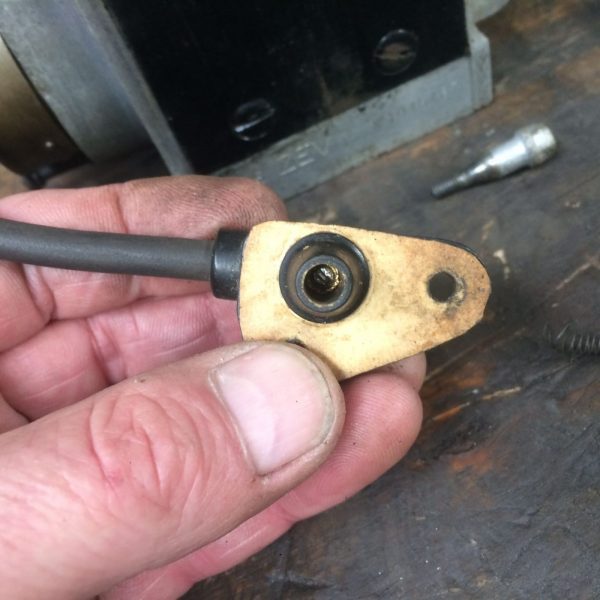

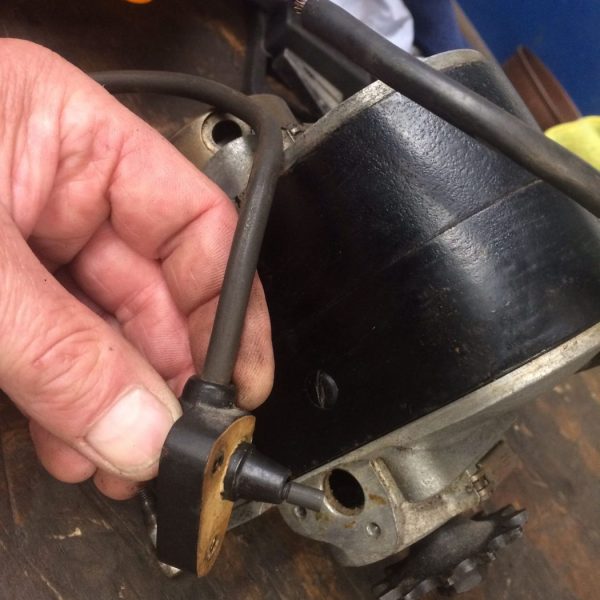

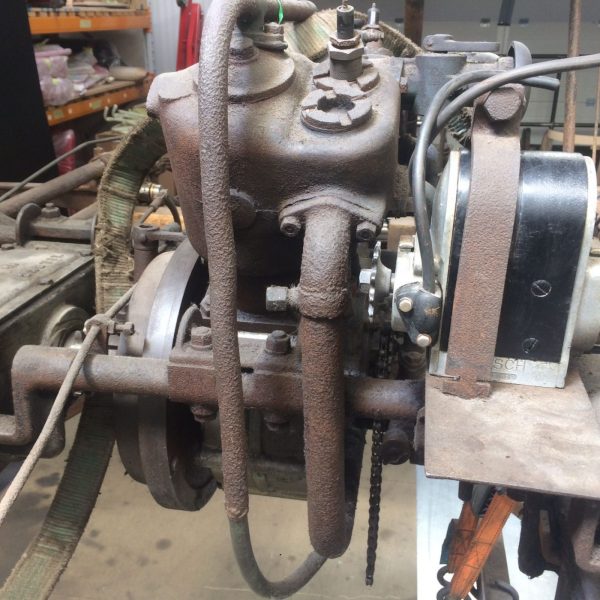
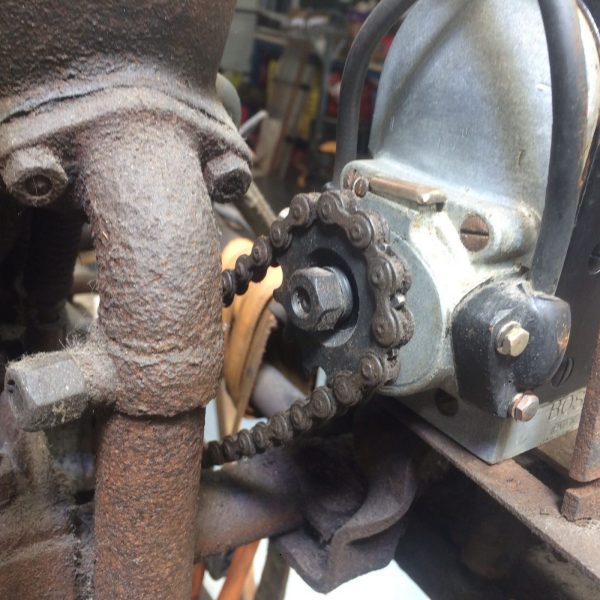
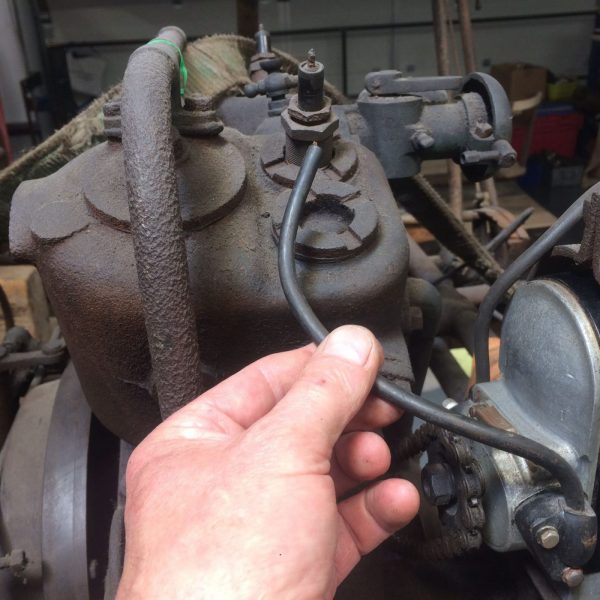
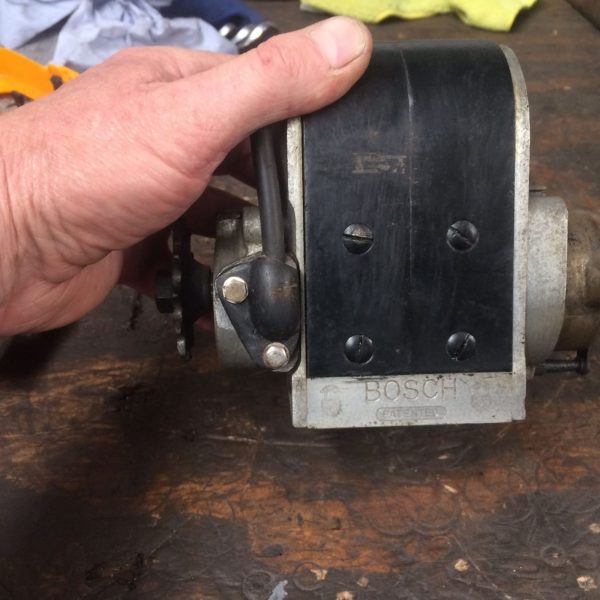
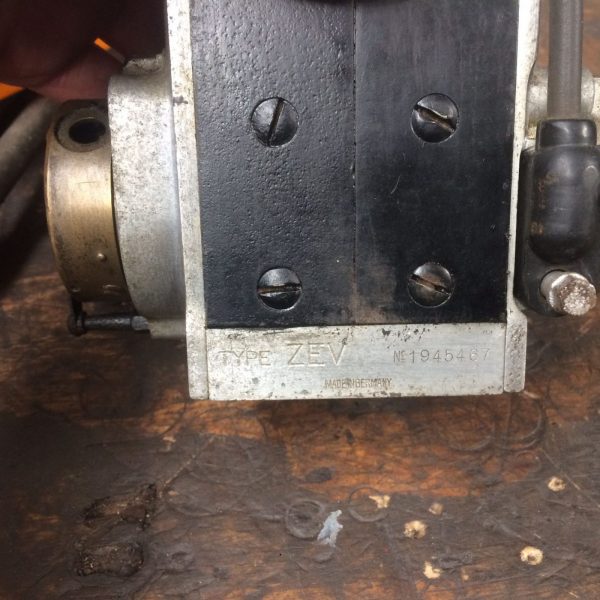

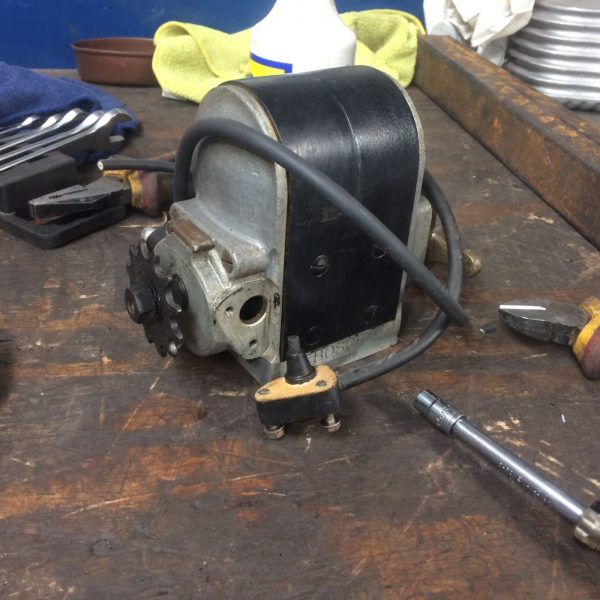
The team at Bridge Classic Cars have been working on the restoration of the 1905 Riley 9HP at our Suffolk HQ.
The magneto is the next item to be worked on by our technicians. Although this particular component was not originally fitted to the car, it was installed by a previous owner to help with starting the classic pre-war touring car. For this piece, the team have installed new HT leads to the magneto which are made to the specific lengths needed for the car.
Then, the team could get it bench-tested to make sure it was producing a strong blue spark and then got it fitted into the chassis and its drive chain put into place.
Check out the video we have of our technician Dave testing the Bosch ZEV magneto on the bench!

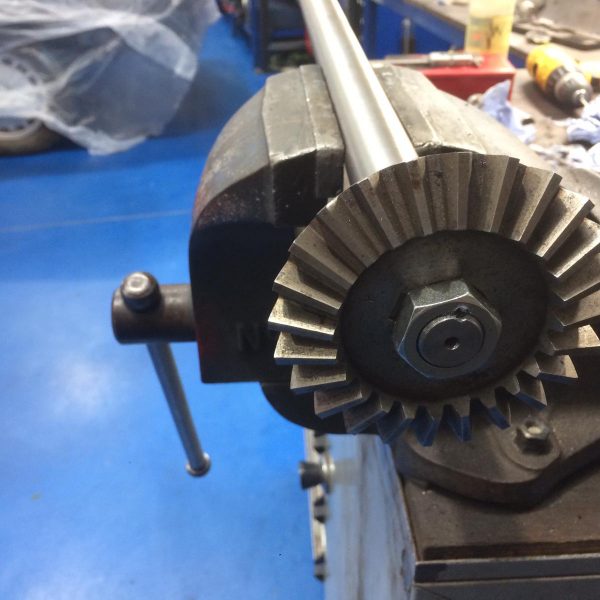
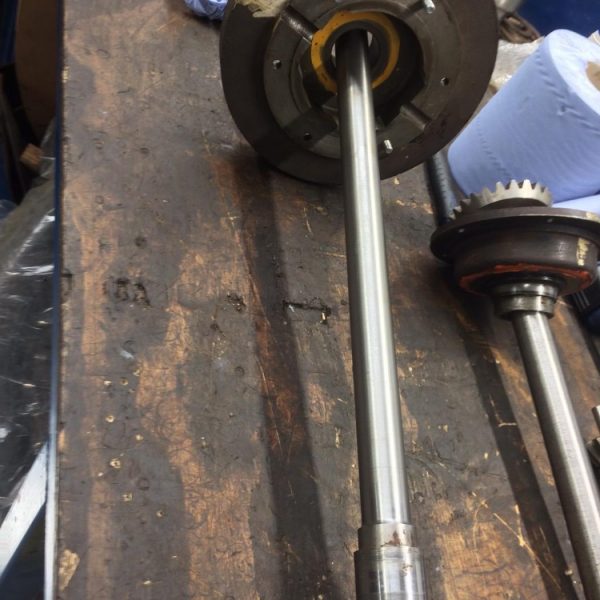

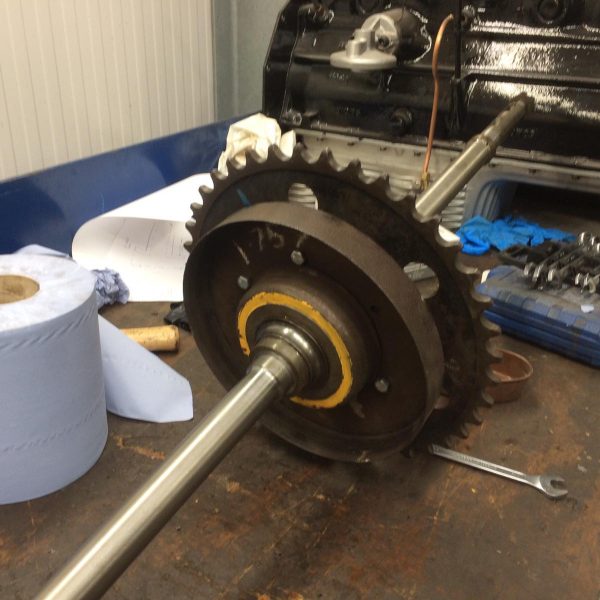
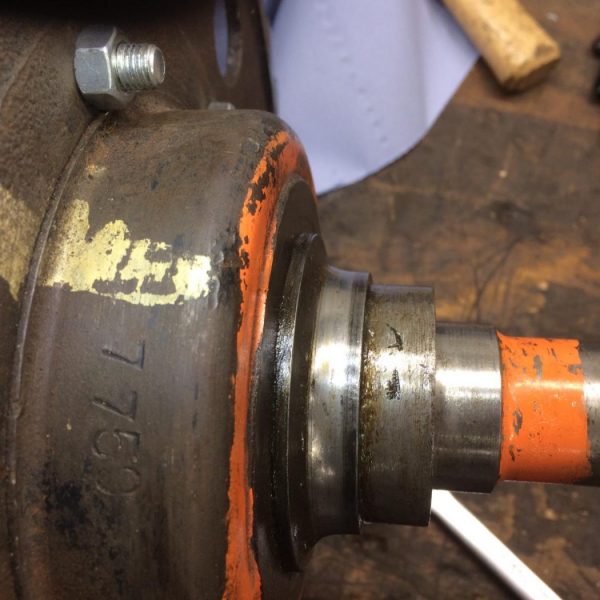

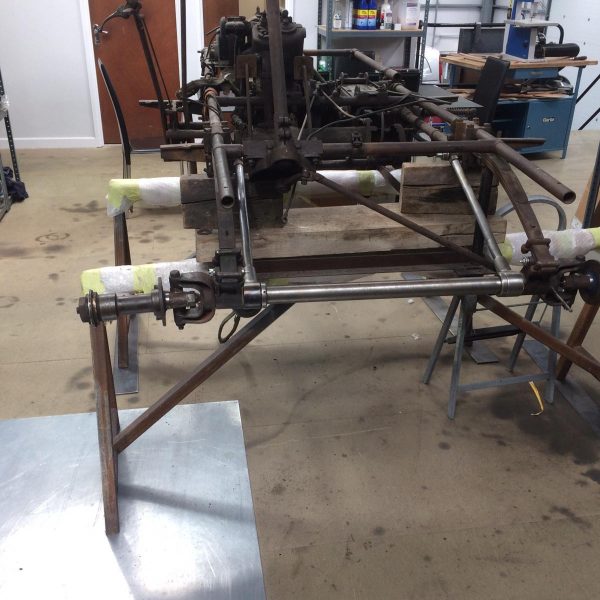
The team at Bridge Classic Cars have performed the first test fit of the new driveshafts in our 1905 Riley 9HP.
They have been fit into the antique, pre-world war 1 Riley to check for fitment and interference. Also, for the team to check the bearing clearances and ring-gear engagement.
There’s a fair bit going on at the moment with the vintage Riley at our Suffolk HQ so make sure to keep an eye on the Bridge Classic Cars news page for more.

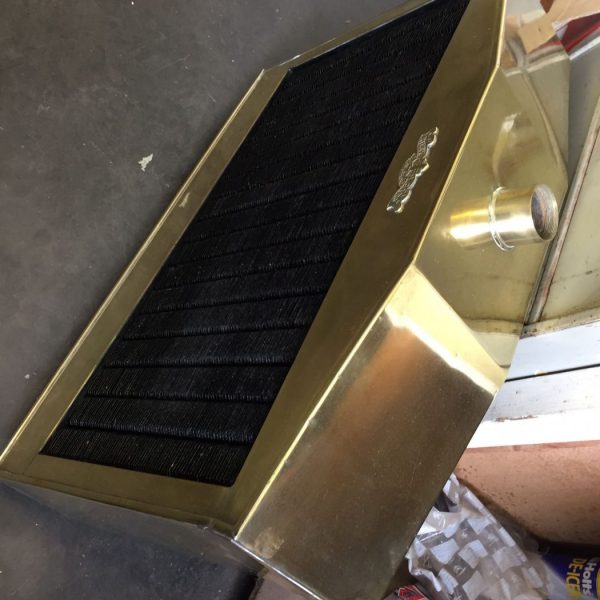
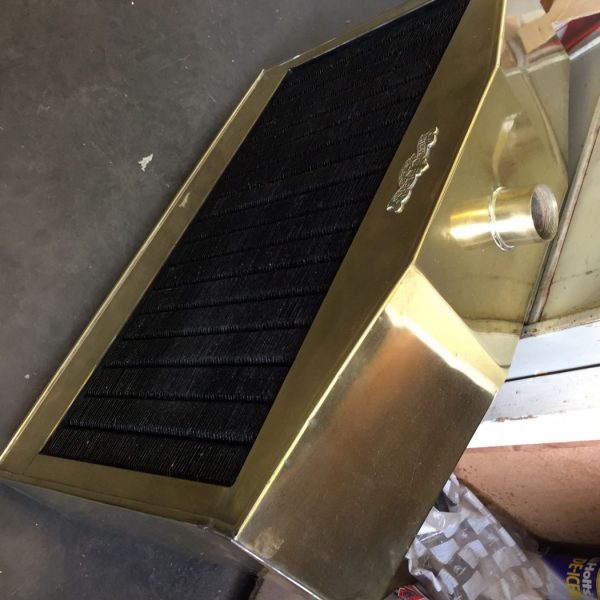
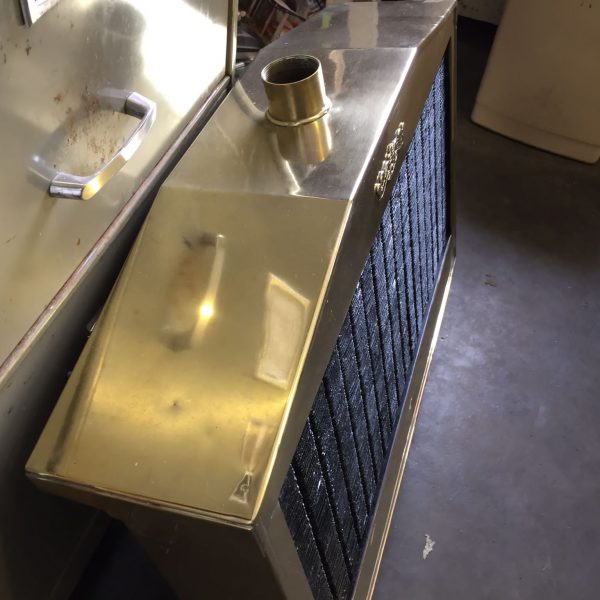
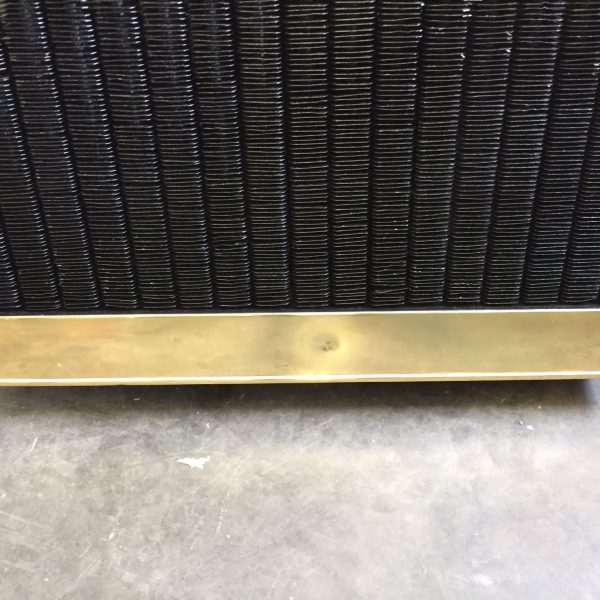
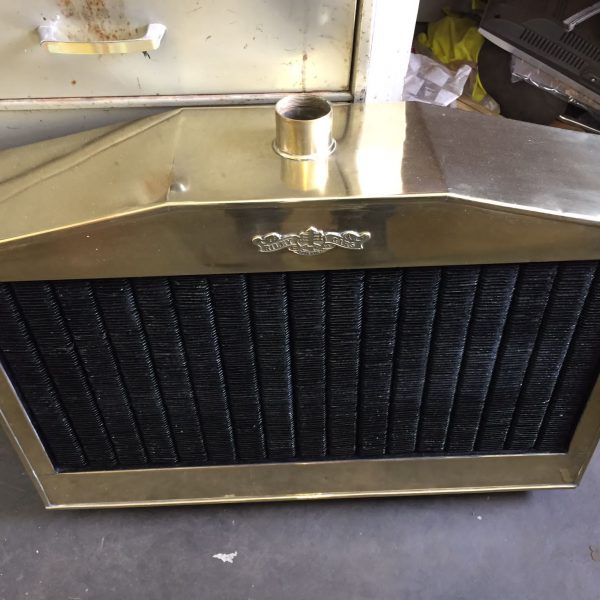
The original radiator for the 1905 Riley 9HP has been with our friends at Newquay Radiators to be completely refurbished and rebuilt for the project.
This is an important part of the restoration project being down by our in-house team at Bridge Classic Cars. It looks absolutely incredible and we love to see the craftsmanship that goes into jobs like this by the best specialists we know.
Bridge Classic Cars are award winning Classic Car Restoration and Maintenance specialists. Your pride and joy is in safe hands with our expert Classic Car Technicians. Take a look at our awards here.